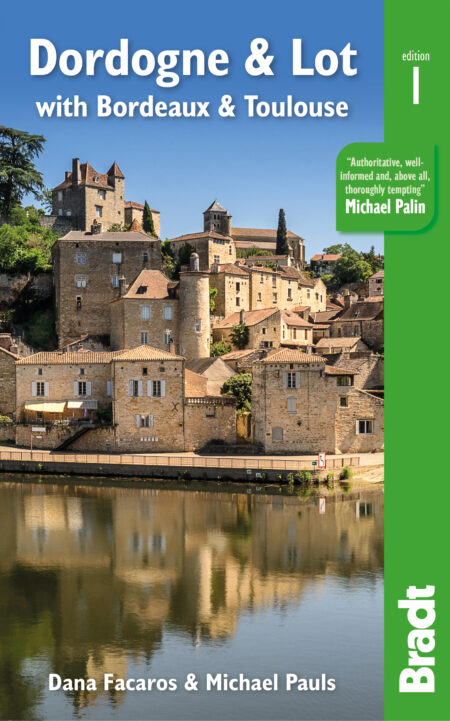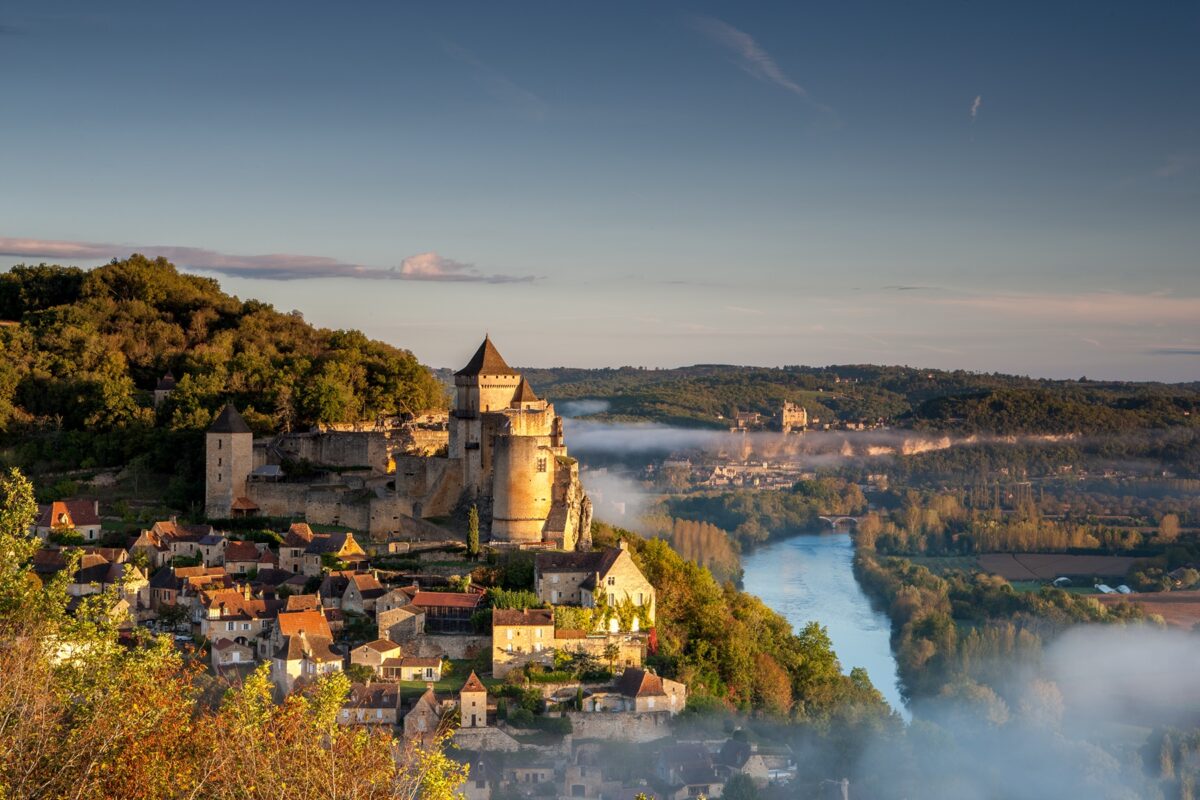For if nothing else, southwest France is indeed a fine place to hear yourself think. The great wine helps, of course, and the delicious regional cuisine puts your digestion in harmony with the universe.
Dana Facaros and Michael Pauls, authors of Dordogne & Lot: the Bradt Guide
France is one of our hot destinations for the year ahead – check out the full list of the best places to travel in 2024 here.
If southwest France could croon a tune, it would have to be that old Inkspots hit ‘I Don’t Want to Set the World on Fire’. Endowed with the soft, gentle beauty of rolling vine-clad hills and valleys and oak and chestnut forests, the region rarely demands your awe and homage. But, like all true lovers, it magically opens your eyes to the grace and charm in little things, in everyday life.
Of course, like any place it has its superlatives, its bragging rights. This is river country par excellence, where waterways born in the Pyrenees and Massif Central – the Dordogne, Lot, Aveyron, Tarn, Garonne and their countless tributaries – put on their brakes to weave gracefully down to the broad estuary of the Gironde and the Atlantic, flowing past a thousand châteaux and as many medieval villages, the world’s foremost wine region and some of its very first great art in the cave paintings of Lascaux, Font-de-Gaume, Pech Merle and a score of others.
Apart from Bordeaux and Toulouse, the two great cities that form the limits of this book, nothing much has happened here since the Hundred Years’ War. Out of history, out of mind, this region retains something that most of the industrialised world has lost in its mad rush towards modernity. The Occitan word is èime, similar to the Catalan seny – the intangible spirit of the nation, its good sense, its spirit of measure and moderation, homeland of France’s most reasonable thinkers, of Montaigne, Fénelon, La Boétie and Montesquieu.
For if nothing else, southwest France is indeed a fine place to hear yourself think. The great wine helps, of course, and the delicious regional cuisine puts your digestion in harmony with the universe. The pace of life is slow, and there’s time to contemplate that old stone farm on the next hill, blending into the environment naturally and effortlessly. The sun-soaked wall by your chair is covered with eglantine and honeysuckle; the fragrance, the flitting butterflies and the blackbirds trilling away make you delightfully drowsy and once again all plans and outings are postponed. You can’t put it off forever, of course – there’s a full whack of sights and surprises for you in this region – but the true purpose of this corner of the world is in teaching us all to pause and regain a bit of perspective. Or, as in the words of Michel de Montaigne:
‘The value of life lies not in the length of days, but in the use we make of them; a man may live long, yet get little from life. Whether you find satisfaction in life depends not on your tale of years, but on your will.’
For more information, check out our guide to Dordogne & Lot:
Food and drink in Dordogne & Lot
Food
Restaurants
A full-on meal in Dordogne & Lot takes at least 2 hours and begins with an apéritif, hors d’œuvres (or amuse-bouches), a starter (entrée), a fish course (poisson), a main course (plat), cheese, dessert, coffee and chocolates or petits fours, and perhaps a digestif to round things off.
For most that only happens at a special meal in a special restaurant, and even Michelin-starred restaurants are increasingly fine with you just ordering a starter and a main course, or a main course and a dessert.
Nearly all offer a good-value lunch with two or more choices on a set-price menu or no choices at all (formule) or even just a plat du jour on the blackboard. Eating à la carte will always be much more expensive – if it’s even offered. Gastronomic restaurants offer a set-price menu dégustation – a tasting menu of the chef’s specialities.
All restaurants post menus outside the door; many now post them on their websites or Facebook, especially if they frequently change.
Specialities of the Bordelais
The cuisine of the Bordelais starts with seafood: the oysters of Arcachon and mussels; from the Gironde estuary come prawns, eels, salmon, salmon trout and, perhaps a bit shocking to the uninitiated, lamprey, a dish so prized that the canons of St-Seurin in Bordeaux gave up all their rights to property in the city in 1170 in exchange for 12 good fat lampreys a year.
Shallots are just as essential to the Bordelais, attaining a kind of epiphany on the famous entrecôte à la Bordelaise with a sauce of butter, shallots, thyme and red wine. Much passion is reserved for cèpes: the true cèpe bordelais (cèpe de chêne or penny bun) and less tasty cèpe des pins. Asparagus, both green and white, is one of the joys of spring in the region.
A speciality revived in the past few decades is milk-fed lamb, or agneau de Pauillac, which holds pride of place among meat dishes along with the beef from Bazas. Among the sweets, try a canelé, a little caramelised pastry said to have been invented by people living around the port of Bordeaux from the flour and sugar left over in the holds of ships.
Specialities of the Périgord and Quercy
For all the blah blah about tradition, the dishes that bring hungry Parisians down here en masse only became popular fare after the Revolution; before then, local barons were so rapacious that the peasants’ diet was based on cabbage, chestnuts, turnips, fruit, and fish if they lived near the river. These days, perhaps to make up for the past, meat is liable to appear in every course except dessert.
The calorie- and cholesterol-conscious can take courage from recent studies showing that the basic southwest diet, with all its duck and goose fat (‘sans beurre et sans reproche’, as the great gastronome Curnonsky described it), garlic and red wine, is actually good for you and your heart; many natives live well into their 90s.
The best place to tuck into a traditional meal is the ferme-auberge, where most of the food has been raised on the spot. A typical meal here or in a good traditional restaurant may start with an apéritif, perhaps a fénelon (a cocktail of walnut liqueur, cassis and Cahors wine). Then comes the tourain (or tourin), a garlic soup cooked with duck or goose fat, ladled over slices of country bread and cheese.
The proper way to finish up the dregs is faire chabrol: pour in a dash of red wine, swish it around, and drink it directly from the bowl.
Drink
Cafés serve drinks, but they are also a home away from home, places to read the papers, play cards, meet friends and just unwind, sit back and watch the world go by. Prices are listed on the tarif des consommations: note they are based on whether you’re served at the bar (au comptoir), at a table (dans la salle) or outside (à la terrasse).
If you order un café you’ll get a small black espresso; if you want milk, order un crème. If you want more than a few drops of caffeine, ask them to make it grand. For decaffeinated, the word is déca. The French only order café au lait (large cup with milk) when they stop in for breakfast; many now offer cappuccinos but they are rarely as good as the ones in Italy. Many have baskets of croissants and pastries to make up a quick, cheap breakfast. Chocolat chaud (hot chocolate) is usually good; if you order thé (tea), you’ll nearly always get an ordinary bag in a little pot unless you go to a special salon du thé.
An infusion or tisane is a herbal tea – camomille, menthe (mint), tilleul (lime or linden blossom) or verveine (verbena). These are kind to the foie, or liver, after you’ve overindulged at table.
One of the joys of travelling (especially here!) is discovering new wines and drinking them for a fraction of what you’d pay at home. Visiting the wine châteaux and vignerons is half the fun (and a good way to save money). Don’t pass up a fête du vin – these usually mean buying a glass and tasting your way around the stands until you discover the ones you like best. Then you can buy a bottle or a carton or more.
Health and safety in Dordogne & Lot
Health
EU citizens with an EHIC (European Health Insurance Card) are entitled to care in Dordogne & Lot from the national health system (which in practice means you are covered for 75–80% of your treatment). As the UK is no longer a member of the European Union, requirements for UK citizens may differ – check before travelling.
All travellers should consider comprehensive travel insurance that includes 24/7 medical assistance, medical expenses and emergency evacuation; accidental death and permanent total disability, baggage loss or delay, money and passport, trip cost cancellation and personal liability.
Health risks
On the whole, health risks are no different from those in other Westernised countries. In summer, aside from the danger posed by over-exposure to the sun, there’s the nuisance of mosquitoes, and the rare possibility of being bitten by a tiger mosquito carrying dengue, chikungunya or even West Nile Virus.
The latter disease typically occurs from May to November. Using an insect repellent containing 50% DEET or 20% Picaridin and applying according to the manufacturer’s instructions can help. Apply sunscreen first, ideally about 20 minutes before applying the insect repellent. Similarly, if you are walking in areas where mosquitoes are prevalent, consider pre-soaking or spraying your outer layers of clothing with permethrin to kill the mosquitoes on contact.
More common now is Lyme’s disease from ticks. Wear light colours when walking in the woods, making it easier to spot a tick in case one lands on you. It is also worth checking yourself at the end of the day, particularly behind the ears, in the groin and under the armpits.
Safety
If you take the same precautions you do at home, you should be fine. Holiday homes that look empty are a prime target for burglars. Report any thefts to the nearest gendarmerie – the reward is the bit of paper you need for an insurance claim. If your passport is stolen, contact the police and your nearest consulate for emergency travel documents. By law, the police in France can stop anyone anywhere and demand ID; in practice, they only tend to do it to harass minorities, the homeless and scruffy.
Drug use is illegal in France but in practice the police only make an issue of victimless crime when it suits them, and there’s not much your consulate can do about it.
In recent years, terrorists have hit France and it is now common to see armed police at airports and popular holiday areas. You can download the SAIP app which gives alerts to any major incident.
Female travellers
Women travelling alone should not encounter any problems, although try to avoid arriving or leaving big city train stations alone late at night, where you might attract unwanted attention. If you are hesitant about travelling alone, download an app such as Find My Phone, Noonlight, bSafe and Life360 which can be used to check in with family or alert the police to your location.
LGBTQ+ travellers
France is a very tolerant country, but in remote villages a certain amount of discretion may be called for as you may encounter confusion, especially among elderly residents. A list of LGBTQ+ friendly hotels, bed and breakfasts, bars, and more, in France is available in English at travelgay.com and dailyxtratravel.com.
Travel and visas in Dordogne & Lot
Visas
Citizens of EU member states and holders of passports from some 50 nations do not need a visa for stays of 90 days or less in Dordogne & Lot. These include Australia, Canada, Hong Kong, Israel, Japan, Malaysia, Mexico, New Zealand, Singapore, South Korea, Switzerland, the UK and the USA. If you intend staying longer than three months, the law says you need a carte de séjour.
Non-EU citizens should kick off the process months in advance by applying for an extended visa at their French consulate before leaving home, a complicated procedure requiring proof of income, etc. You can’t get a carte de séjour without this visa, a trial run for the ennui you’ll undergo in applying for a carte de séjour at your local prefecture. See france-visas.gouv.fr/en/web/france-visas/long-stay-visa.
Travel to Dordogne & Lot
By air
The major international airports in the region are at Bordeaux and Toulouse, both of which have direct connections with numerous airports in the UK and Ireland and around Europe. There’s also a small-scale international airport at Bergerac, and a smaller one at Brive-Souillac. Others in the vicinity are in Limoges (90mins from Périgueux by train or car) and Rodez (an hour’s drive from Figeac). Destinations and airlines keep changing, though, so it is always worth browsing Skyscanner.
From North America, the only direct flights to southwest France are from Montreal on Air-Transat, which fly direct to Bordeaux and Toulouse from May to September. Otherwise, your best option may be to find a cheap flight to a European hub then continue from there to Bordeaux or Toulouse. If you fly into Charles-de-Gaulle (Roissy), there are direct fast LGV trains to Libourne and Bordeaux from the airport.
By rail
From the UK, travelling from London St Pancras to Bordeaux can take as little as 6 hours with Eurostar, changing in Paris (Gare du Nord to Gare de Montparnasse; see thetrainline.com for options). You’ll save money if you purchase tickets in advance (up to 180 days before your return date). There are discounts on the Eurostar for children aged 4–11; under 4s travel for free.
For the Dordogne or Lot, an Intercity train from Paris Austerlitz to Périgueux 2 (via Limoges) or Cahors might be quickest. Another option is the overnight sleeper (intercité de nuit), leaving Paris Austerlitz at 22.00 and arriving in Toulouse at 06.00. Check out options on the French SNCF rail website, which now includes BlaBlaCar car sharing and Hiflow vehicle transport options.
By road
It’s 1,028km (an 11hr drive) from London to Bordeaux by way of the Eurotunnel and autoroutes (toll motorways), and at the time of writing this costs around €220 in tolls and fuel. The Michelin website is useful for calculating routes, times, traffic conditions, and petrol and toll prices in France.
Drivers with a valid permit from an EU country, the UK, Canada, the USA or Australia don’t need an international licence. A car entering France must have its registration and insurance papers. If you’re coming from the UK or Ireland, the dip of the headlights must be adjusted to the right. Carrying a warning triangle and yellow vest inside the car is mandatory; the triangle should be placed 50m behind the car if you have a breakdown.
By sea
The Dover–Calais ferries offer the most frequent crossings, although ferries from Portsmouth to Caen (plus 603 km/5½ hrs onward drive to Bordeaux) may be a good option, depending on where you live.
Getting around Dordogne & Lot
By rail
Southwest France has a decent network of fast TGVs and LGVs, long-distance intercity and regional (TER) trains, although smaller lines may have only two or three connections a day, and may use buses to replace the rail service. Many trains will transport bicycles (look for the logo on the timetable and book a ticket (€10 or €5) for your bike; on TERs use of the special bike car is free, operating on a first come, first served basis). Fares are still reasonable, and discounts are available, especially if you book early and travel off-peak; see sncf-connect.com, which now also lists available BlaBlaCar car-shares.
By bus and other public transport
Do not count on seeing much of rural France by bus. The network is barely adequate between major cities and towns and rotten in rural areas. However, to make finding routes and schedules easier, all have been put under regional umbrellas: for the Gironde, Dordogne and Lot-et-Garonne, see transports.nouvelle-aquitaine.fr; for the Lot, Tarn-et-Garonne and Toulouse, see lio.laregion.fr. Cities will have a gare routière (coach station), which is usually just a small parking area near the train station. To help get around the public transport systems of Bordeaux and Toulouse, download the Citymapper app.
By car
Unless you stick to the major towns, cycle or walk, a car is the only way to see the area. Roads are generally excellently maintained, but don’t blindly rely on GPS for ‘the shortest route’ as it can take you down some very narrow hilly back roads and take twice as long as it should.
The price of petrol (sans plomb, unleaded; gasoil, diesel) varies considerably, with motorways always more expensive and supermarkets always the cheapest; all are nearly always open 24/7 with self-service – if you have a debit or credit card with the right chip and a four-digit code. Otherwise try to buy your fuel during working hours; the big supermarkets will have someone in the booth to take your cash or credit card. Drivers of electric vehicles will find fast-chargers along the autoroutes and others in village car parks, by supermarkets and hotels. Download one of the European apps, Chargemap or Plug Share, to find them; also check out advice from the AA. Not all charging stations in rural France work well with just the app but there is always a number to ring for help.
When to visit Dordogne & Lot
Winter can be a bleak time to visit Dordogne & Lot outside of Bordeaux and Toulouse, which are always lively and full of things to see and do. Elsewhere hotels, restaurants and sights (including most caves and châteaux) simply close down, and the skies are often cloudy all day. The first crocuses often show up in January (which is also peak truffle season) but, whatever the weather, things are pretty sleepy until March. Spring-term school holidays and Easter week bring the first tourist rush of the year, but nothing too dramatic. May and June, usually warm and not too crowded, are among the best times to visit.
Hot July and August are French school holidays, when the countryside comes to life with thousands of holidaymakers. Towns and attractions are crowded, prices rise and there are scores of festivals, village fêtes, fairs, concerts and more. In late September/early October, when the tourists have gone and everyone is concentrating on the wine harvest, the vineyards turn golden and red in romantic mists. November and December can be dismal and wet, but wild mushrooms, truffles, walnuts and game dishes offer some consolation, along with the Christmas concerts and fairs.
Climate
The Aquitaine Basin, shielded from intemperate Continental influences by the Massif Central, has a fairly balmy, humid Atlantic climate, with long hot summers broken by heavy thunderstorms. Early spring and late autumn usually get the most rainfall – and it can rain for weeks at a time. Winters are fairly mild, with only 20–40 days of frost a year, although every 30 years (on average) killer frosts descend: the one in 1956 killed off 95% of the vines.
Of late the weather has been capricious and strange, so it’s impossible to predict what you might get: after five years of drought, which produced some of the greatest wine of the 20th century, the autumns of 1992 and ’93 saw endless rain and floods. December 1999 saw some of the strongest and most destructive storms in France’s recent history, and then 2003 produced a summer of relentless, unforgiving heat. Extreme April frosts have troubled the vineyards again in recent years, most recently in 2021.
Festivals and annual events
The French know how to throw a party. Every village celebrates at least once a year: up go the fairy lights and flags, the big tables and folding chairs for a feast (you must book ahead and look for your name scrawled on the paper tablecloth) and a platform for the band – larger towns can afford both a bal musette (accordion waltzes, tangos and French songs) and a local pop band that might just play until dawn. In larger villages, a travelling funfair and/or circus pulls into town; there will be fireworks if the mairie has the money to spare.
One of the oldest festivals, the century-plus-old La Félibrée takes place in a different town in the Dordogne every year, with traditional music, dance and food, organised by Lo Bornat dau Perigòrd. In 2021, the Dordogne and Lot-et-Garonne combined to create a new event, the Châteaux en Fête, with all kinds of day and night activities from late May to mid-June. On or around 21 June it’s time for the national Fête de la Musique, with free concerts in hundreds of places. The third weekend in September sees the Journées du Patrimoine, when usually closed châteaux and other historic sites open their doors.
In June, each department publishes a guide to its summer events, but check with the relevant tourist offices before setting out as dates can change.
What to see and do in Dordogne & Lot
Cahors
The immediate surroundings of Cahors are some of the most discouraging landscapes in all France. The anomic clutter of the newer parts of town matches them well, but persevere – in the middle you’ll find a medieval city of surprising subtlety and character. Its star attraction is the Pont Valentré, which, as any Frenchman will tell you, is the most beautiful bridge on this planet.
What to see and do in Cahors
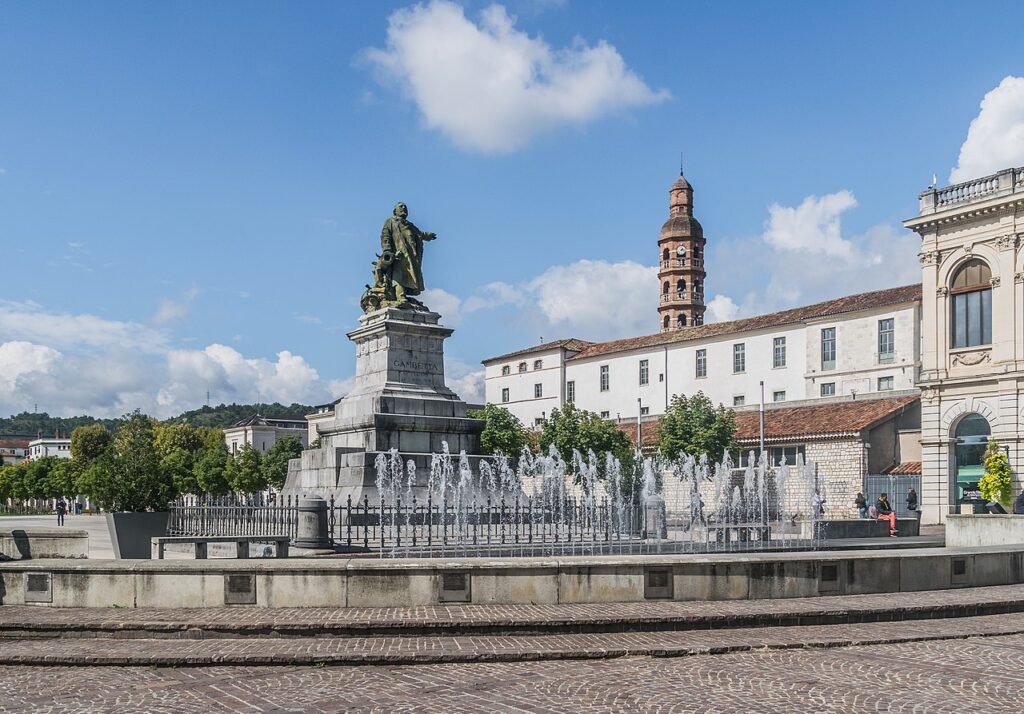
Boulevard Gambetta
A canopy of plane trees shades the city’s main shopping street, replacing its medieval walls. Near the tourist office in Place François Mitterrand, an appropriately flamboyant monument to Léon Gambetta, shows Cahors’s Republican hero pointing dramatically, perhaps accusingly, north towards Paris.
As a lawyer and politician, Gambetta was a strong opponent of Napoleon III. After France’s defeat in 1870, he declared the Third Republic in Paris, and then dramatically escaped from the city in a balloon while the Prussians were besieging it. After that, he raised new armies in the south (though the Prussians whipped them too), and eventually became premier; all France mourned in 1882 when he accidentally killed himself while cleaning a gun.
If you stroll to the end of the Allées Fénelon behind Gambetta, have a look at the handsome Collège Gambetta on the right with its octagonal red-brick bell tower, a survivor of the 17th-century Jesuit college that stood here first. The Allées are closed off by a pretty Neptune fountain; turn right here for Rue du Président Wilson.
Pont Valentré
If anything is a sign of opulence in a medieval city, it’s the bridges. Cahors had three, where one would have sufficed, and the two that have disappeared, demolished in 1868 and 1907, were almost as good as this one. The Pont Valentré survived because it carried little traffic. Begun in 1308, and financed with the help of Pope John, the bridge nevertheless took 70 years to complete. With the Hundred Years’ War in full swing, it isn’t surprising that defence became the major consideration. The three towers that look so picturesque are three rings of defences to keep the English out; each had its portcullis, and slits for archers and boiling oil.
You can be sure the Devil had something to do with it. Here after working on the project for decades, the master builder made a deal with Old Nick: if he would do whatever the builder told him to do with his supernatural powers to finish the bridge, he would forfeit his soul. After the bridge was finished, the builder tricked him, of course, by giving him a sieve and ordering him to fetch water, but the Devil got his revenge by sending a demon to steal one of the stones near the top of the central tower, which had to be replaced every day. In the 19th century, restorers added the stone carved with a devil to trick Satan into thinking his orders were still being followed.
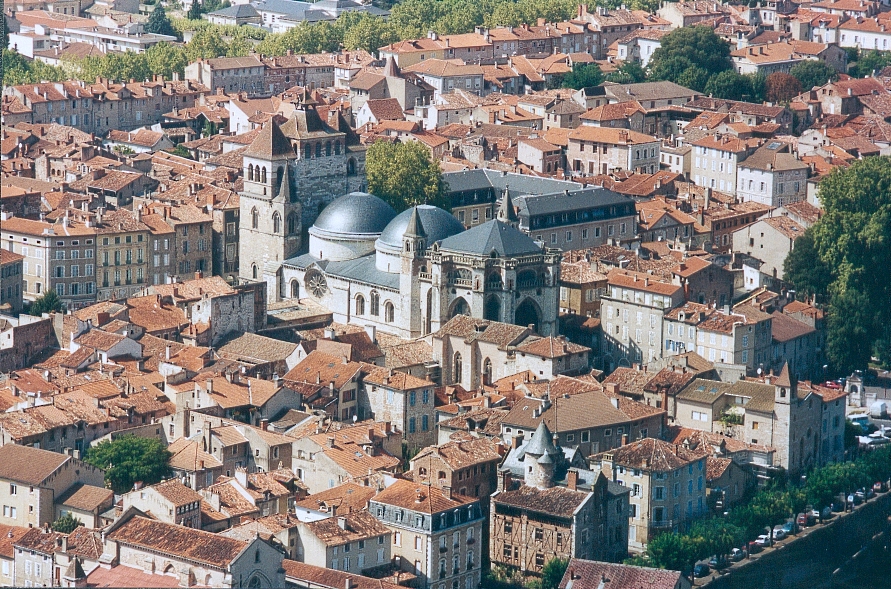
Cathédral de St-Étienne
Medieval Cahors is clustered east of Boulevard Gambetta under its mighty cathedral. Begun in the 10th century on the site of St Didier’s 7th-century church, this was the second of the domed churches of Périgord and Quercy, directly inspired by St-Étienne in Périgueux. Not completed until the 1400s, its western and eastern ends were completely rebuilt, resulting in a not unlovely architectural mongrel, a kind of Romanesque-on-Gothic sandwich.
The severe façade, the typical broad clocher-mur of a Quercy church writ large, was redone in the 14th century, when the original entrance was moved around to the side – then walled in and forgotten until 1840. This, the north portal, is one of the finest in southern France.
In the centre, Christ in a mandorla is flanked by angels tumbling down out of the heavens, and scenes of the martyrdom of St Stephen; below are the Virgin Mary and ten apostles (there wasn’t room for 12). The borders and modillions are fascinating, with a full complement of monsters, scenes of war and violence, and unusual decorative rose motifs that seem to prefigure the trimmings on Cahors’s Renaissance palaces.
Quartier des Badernes
South of the cathedral, this was the popular quarter of the city – though it had its share of palaces, mostly along Rue Nationale, the main street in medieval times; at its beginning, the Hôtel de Marcilhac has a lovely Baroque carved door. The narrow lanes to the left off Rue Nationale, give an idea of how dense urban life was in Cahors, with numerous half-timbered houses, and medieval palaces along Rue Lastié; many of these have big, pointed arches facing the street for the business façades and elegant twinned windows on the family quarters upstairs. Another feature is the soleiho, a sun porch on the top; in Renaissance palaces they are often made of brick arches and called mirandes.
The neighbourhood’s church, St-Urcisse, stands at the end of Rue Clemenceau with a 13th-century statue of the Virgin on the façade; if it’s open, don’t miss the set of carved capitals with fond naïve scenes of Adam and Eve and the Life of Christ. In Place St-Urcisse by the river, the hypnotic Horloge à Billes created by Michel Zachariou keeps the time with 54 marbles.
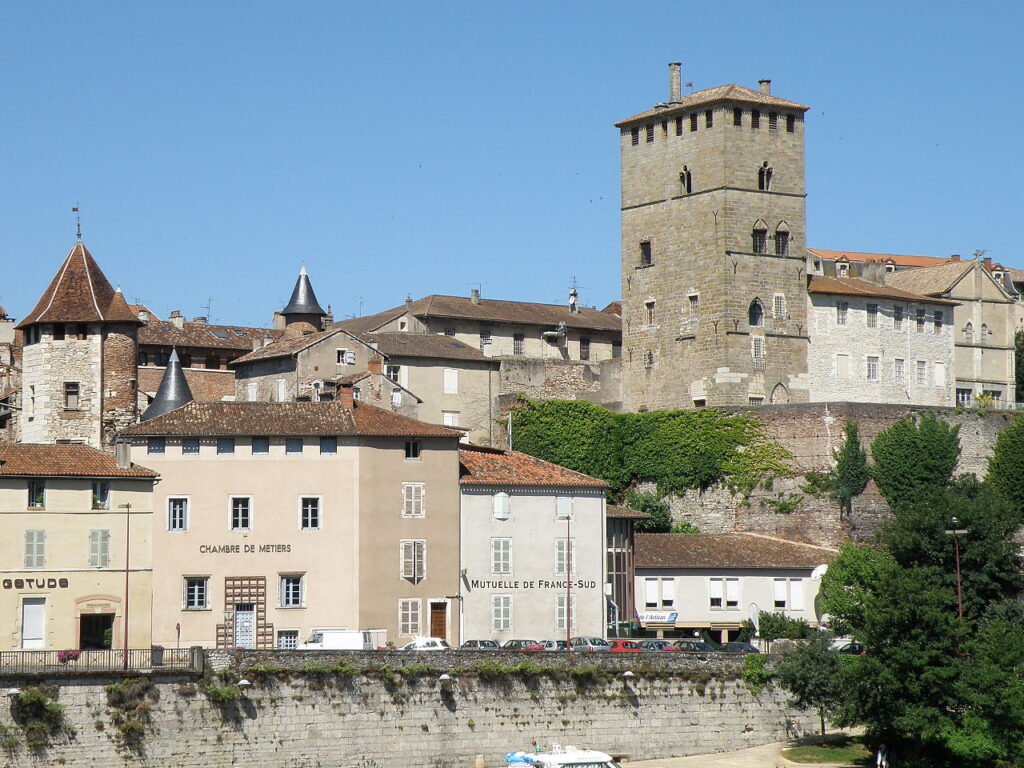
Quartier des Soubirous
North of the cathedral extends what was the wealthy merchants’ quarter; soubirous means superior, for the way it climbs uphill. Its spine, Rue du Château-du-Roi, is an elegant street reminiscent of Siena or Perugia. Its most impressive façade is at no. 102, the 13th-century Hôpital de Grossia.
Across from the Hôpital, the Château du Roi was one of Cahors’s grandest palaces in the 1300s, built by the pope’s brother-in-law but it was thoroughly wrecked in the 19th century when the state converted it into a prison; the tall donjon inside, visible only from the riverfront, once had a tall chimney as a landmark for river boatmen. Plans are to make it into a hotel and cultural centre.
Figeac
Figeac, the metropolis of the Célé valley, has more than one feather in its cap. It gave the world Jean-François Champollion, the linguistic wizard who cracked Egyptian hieroglyphics, and Charles Boyer, the archetypical French lover of the silver screen (and the inspiration for Warner Bros’ cartoon skunk, Pepé le Pew). Near the frontiers of the Aveyron, Figeac is the second city of the Lot, with all of 9,000 people; it has more obelisks than Paris, and lays fair claim to flexing the Lot’s industrial muscle, thanks to the aeronautics manufacturer Ratier.
But for the casual visitor, it’s Figeac’s medieval heart of golden sandstone that comes as the most charming surprise of all – it’s arguably the most beautiful medieval French city that most people (including the French themselves!) have never heard of. There may be no canals, but there’s something vaguely Venetian about Figeac, beginning with its medieval plan, full of curving lanes and irregular, asymmetrical little squares, offering a wealth of visual surprises.
The stone houses are so tall and densely built that many are topped with covered rooftop terraces that the Venetians call altane and the Lotois call soleihos, which not only offered city-dwellers a breath of fresh air but came in handy for drying fabrics, fruit and nuts. As in Venice as well, the ground floors were given over to stocking merchandise, while the merchants lived upstairs on the piano nobile, usually lit with the most elaborate windows of the building.
What to see and do in Figeac
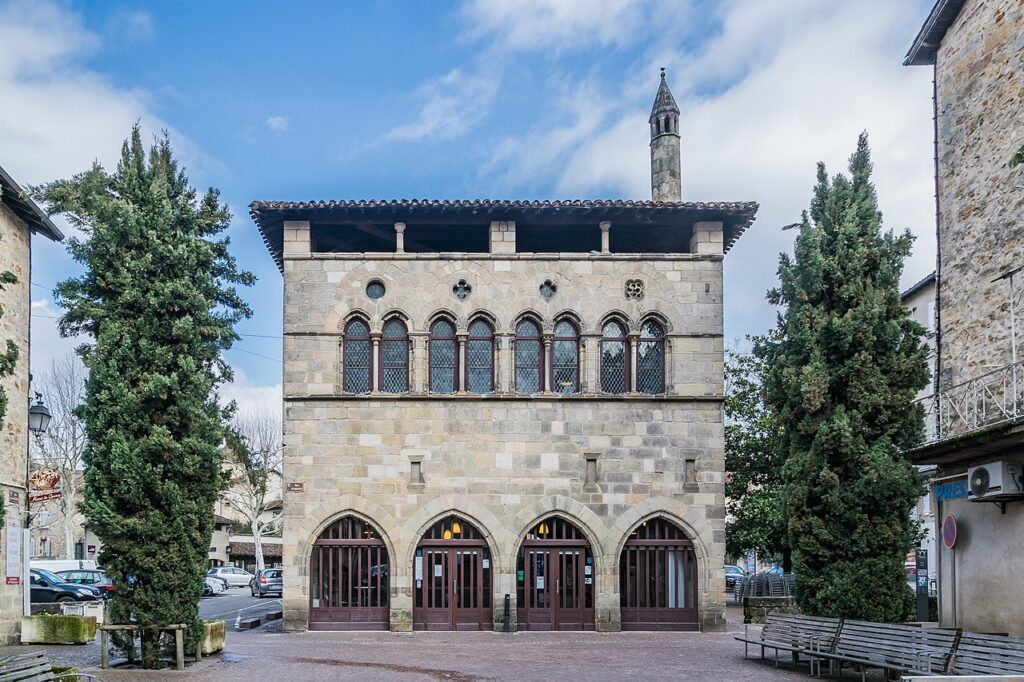
Hôtel de la Monnaie
The tourist office occupies this elegant 13th-century palace, one of the finest secular buildings of the period in France. Philippe IV granted Figeac the privilege of minting its own coins, a dandy boost to commerce in those days; the ground floor with its pointed arches was used as a bank, while on top is a typical soleiho.
Just west of Place Vival runs charming Rue Caviale, where the Hôtel de Marroncles at no. 30 hosted Louis XI in 1463. Rue Caviale gives into Place Carnot, Figeac’s ancient market square, although since 1988 sadly lacking its 13th-century grain halle. Note the well-preserved 13th–17th-century Maison Cisteron in the corner, with a turret: this was the residence of Pierre de Cisteron, master armourer of Louis XIV and a Huguenot. Just before revoking the Edict of Nantes, Louis sent down a special safeguard for Cisteron, to keep him from the persecutions he had in store for Protestants not so dear to his heart.
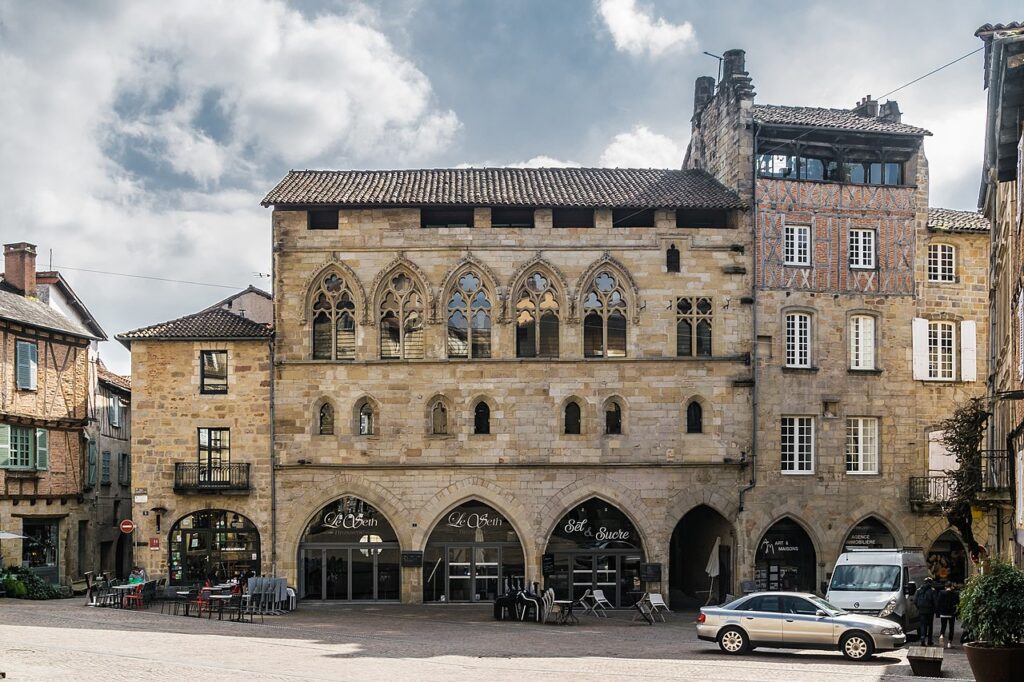
Place Champollion
For centuries this held Figeac’s chestnut market; until the 19th century chestnuts were staple in the local diet, ground into flour for bread. The butchers had their stands under the ogival arches; note, too, the 12th-century Maison du Griffon at no. 4.
The square is named after the 14th-century birthplace of Jean François Champollion (1790–1832), who by age 14 could rattle away in Latin, Greek, Hebrew and Arabic. He was always fascinated by Egyptian hieroglyphics, and when he finally saw a copy of the British Museum’s Rosetta Stone in 1822, he made his great discovery and confirmed his belief that the ‘pictures’ were a form of writing.
The alphabet-covered Musée Champollion–Les Écritures du Monde offers four floors of somewhat didactic displays; there are three mummies and a small but choice collection of ancient Egyptian and Coptic art, as well as a painting of our man in Egypt, dressed in native costume, looking for all the world like a brigand with his bushy black beard and scimitar. In the Place des Écritures, Champollion’s bicentenary in 1991 was celebrated with the installation of a giant facsimile of the Rosetta Stone in the pavement, designed by American artist Joseph Kosuth.
Notre-Dame du Puy
Figeac’s churches haven’t withstood the trials of time as successfully as its secular buildings. This much-tampered-with 12th-century church overlooking the town replaces an ancient chapel where the Virgin made a rose bloom on Christmas Day, and retains some 14th-century carvings on its portal and capitals. The ornate 17th-century rooms of the former seminary here house Figeac’s attic – the Musée d’Histoire de Figeac with a mix of prehistoric relics, paintings, gifts from President Pompidou and other odds and ends.
Abbaye St-Sauveur
Encased in a forgettable 19th-century façade and bell tower crowned with a giant bread box, only St-Sauveur’s large size hints that this was Figeac’s famous medieval church. The chapterhouse (now a chapel off the right aisle) was given its remarkable ogival vaulting in the 15th century; in the 17th century, to cover up some of the damage caused in the Wars of Religion, a local sculptor added the naïve painted reliefs of the Passion – including a Last Supper of roast hamster and a bizarre scene of baby Jesus sleeping sweetly on a cross, dreaming of his future torments. In the adjacent riverside Place de la Raison stands a small obelisk, a monument to Champollion.
Just before the river, Rue du Balène winds past the Hôtel du Balène with its huge ogival door and Flamboyant windows. From here Rue Orthabadial, once the realm of the medieval abbey gardener, returns you to the Hôtel de la Monnaie. The most picturesque descent from Notre-Dame is by way of Rue Delzhens, past the seat of the king’s judge, the Hôtel du Viguier (1300s, now a hotel), to Rue Roquefort, where at no. 12 are the elegant remains of the house built by Galiot de Genouillac.
Grotte de Font-de-Gaume
Thirteen visitors at a time are allowed into Font-de-Gaume, a 10-minute walk east along the D47 in Les Eyzies region. It has nothing less than the finest polychrome prehistoric paintings open to the public in France, although as in Rouffignac the cave was visited centuries before the the artwork was actually ‘discovered’ in 1901.
It’s a bit of a steep walk up to the entrance. Inside, beyond a narrow passage called ‘the Rubicon’, the walls are adorned with beautiful paintings and engravings in remarkable flowing lines dating from 12,000 BC, created with the same drawing and colour-blowing techniques used at Lascaux: magnificent friezes of red and black bison on a light background, reindeer, horses with legs and heads partially formed by natural features in the cave walls.
The guide will adjust the lighting to bring out the extraordinary fullness and depth of the art. The partially painted, partially engraved black stag and kneeling red doe are unique in the canon of Upper Palaeolithic art, and only become visible after the guide carefully traces out the lines with a light. The stag is leaning over delicately to lick the doe’s brow, an image of tenderness as sublime as it is startling, and one that questions a lot of commonly held assumptions about life 14,000 years ago.
Moissac
There’s one reason to make the trip to Moissac, but it’s a solid five-star reason: the Abbaye de St-Pierre, one of the crown jewels of medieval French sculpture. The town of Moissac, washed clean of most of its character in a tragic flood in 1930 which killed more than a hundred people and destroyed more than 600 buildings in Moissac alone, led the French president to declare the first ever day of national mourning.
Less than ten years later, a house at 18 Quai du Port was used to shelter 500 Jewish children from across France and Belgium – common knowledge in Moissac, but no-one ever gave them away; when the local police got wind that a raid was planned, all the children were dispersed among the locals and never found. Ten Moissagais and the entire town were recognised as Righteous Among Nations – hence the shock in 2020 when the usual left-wing town elected a mayor accused of antisemitism from the party of Marine Le Pen, mostly through resentment over fruit pickers from Eastern Europe undercutting local wages.
Today Moissac busies itself taking care of the 15,000 pilgrims who pass through the region every year (from the traditional starting point at Le Puy, it’s a quarter of the way to Compostela) and growing aromatic pale golden chasselas, ‘the caviar of grapes’, cultivated by the abbey in the Middle Ages and the first French fruit to attain AOC status in 1952.
What to see and do in Moissac
Moissac Abbey
The first Benedictine monastery was founded here by Clovis in 506 AD, commemorating his victory over the Visigoths. The battle had cost him a thousand men, whom Clovis declared would be remembered by an abbey of a thousand monks. Exactly marking the spot of such an important religious foundation being a very serious matter, Clovis, as the legend goes, climbed a hill and hurled his trusty javelin, telling God to guide it where he saw fit. Gshshloop! went the javelin as it struck the gooey muck of a marsh. Never questioning God’s peculiar choice, Clovis ordered his builders to get on with it. He had to order them three times. In the end they had to sink deep piles to support the structure. No-one knows if the story has a germ of truth in it, or if the monks made it up to explain their annoying problems with rising damp.
The porch
Given Moissac’s record of trouble, the great abbot Ansquitil decided in 1115 to fortify the church with a tower. Sheltered underneath is the sublime porch, one of the most powerful and beautiful works of the Middle Ages; the men who commissioned it are remembered in the two statues on pilasters off on either side, Abbot Ansquitil on the left and on the right Abbot Roger (1115–35), who completed the work after Ansquitil’s death.
The tympanum, originally vividly painted, rests on a lintel recycled from a Gallo-Roman building, decorated with eight large thistle flowers and enclosed in a cable or vine, spat out by a monster at one end and swallowed by another monster at the other. The main scene represents one of the key visions of the Apocalypse, of Christ sitting in the Judgement of Nations, with the Book of Life in his hand (‘And he who sat there appeared like jasper and carnelian, and round the throne was a rainbow that looked like an emerald…and before the throne there is as it were a sea of glass, like crystal’). You might notice that this Christ has three arms, one on the book, one raised in blessing, and another on his heart, but please don’t ask for an explanation: no-one’s come up with a convincing one yet.
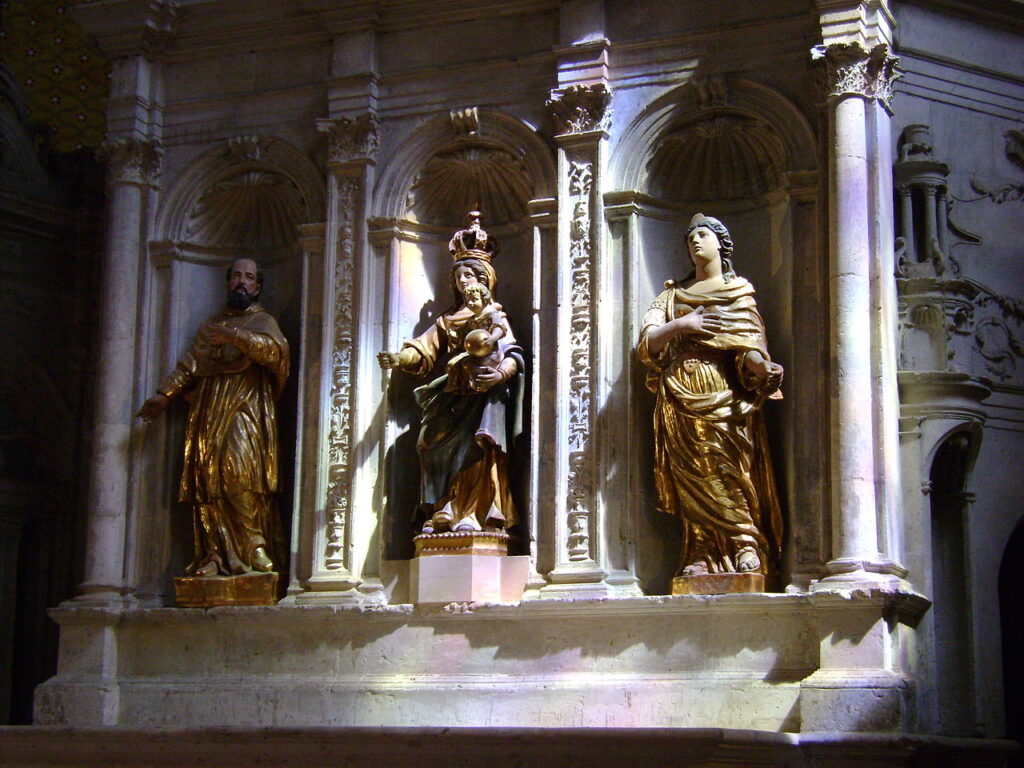
The church
Inside the porch, the vaulted square of the narthex has some excellent Romanesque capitals, carved with voluptuous vegetation playfully metamorphosed into animals; one shows Samson wrestling with a lion. The church’s interior had to be rebuilt in 1430 and can’t begin to compete with the fireworks on the portal. You can see the foundations of the Romanesque church of 1180 (along the bottom of the Gothic nave), which like that at Cahors was crowned with a row of domes; unlike Cahors, they collapsed and have been replaced with Flamboyant Gothic vaults.
Only one chapel retains its 15th-century geometrical murals, which inspired the restoration on the other walls. Some of the church’s polychrome sculpture survives, especially a 12th-century Christ and, from the 15th century, the Flight into Egypt with a serious-minded donkey, the beautiful Entombment and a Pietà (the figure with the swollen head is Gaussen de la Garrigue, consul of Moissac). The Baroque organ consul bears the arms of Cardinal Mazarin, abbé commanditaire from 1644 to 1661 and one of the most successful grafters of all time.
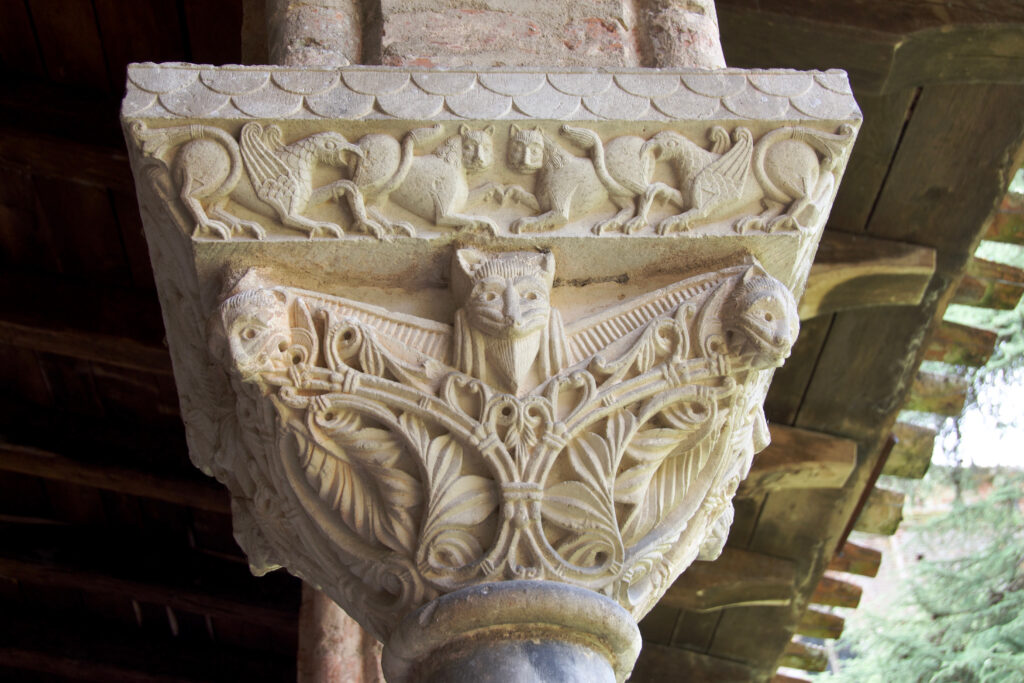
The cloister
Behind the church is the abbey’s serenely magnificent cloister, built by abbots Durand de Bredon and Ansquitil. After Simon de Montfort sacked Moissac, the arches had to be rebuilt, and were given a gentle hint of a Gothic point (1260), but all the 76 magnificent capitals, set on alternating paired and single slender columns of various coloured marbles, come from the end of the 11th century; they are the oldest in situ in France.
They also mark a major artistic turning point, away from the immobile, rather stiff, hieratical figures of the great Guilduin (as in Toulouse’s St-Sernin) towards more fluid, stylised poses with a sense of movement, exquisite modelling, and a play of light and shadow hitherto unknown in Romanesque sculpture. The capitals are carved with foliage inspired by Corinthian capitals, but with luxuriant virtuosity; others have birds and animals intertwined.
Some 46 capitals tell the lives of the saints – don’t miss the dynamic martyrdoms: St Lawrence burning on the grill while two Romans blow on the flames; St Martin dividing his cloak with the beggar; St John the Baptist and the feast of Herod; St Stephen being stoned; St Peter upside down on his cross next to St Paul’s beheading; a capital set near a little niche that once contained some of their relics. Other scenes are rare – the City of Jerusalem vs Unholy Babylon, the Story of Nebuchadnezzar, and Shadrach, Meshach and Abednego in the Furnace.
At the corners and in the centre of each gallery are square pillars, covered with the tops of Roman sarcophagi; the corners are carved with bas-reliefs of eight apostles, the ‘pillars of the Church’; the central pillar in the east gallery has an effigy of Abbot Durand de Bredon, while on the west there’s the dedication inscription: ‘In the year of the Incarnation of the eternal Father 1100, this cloister was completed in the time of Lord Ansquitil, Abbot, Amen.’
Périgueux
Set in a privileged, fertile valley on the River Isle, the capital of the Dordogne département is a cheerful city of 31,600 people who print all the postage stamps in France. The old streets around its famous five-domed cathedral have been intelligently restored to give the city a lively and lovely heart. Another plus are two excellent museums, old and new, offering a chance to get to know what life was like here in the time of Asterix.
What to see and do in Périgueux
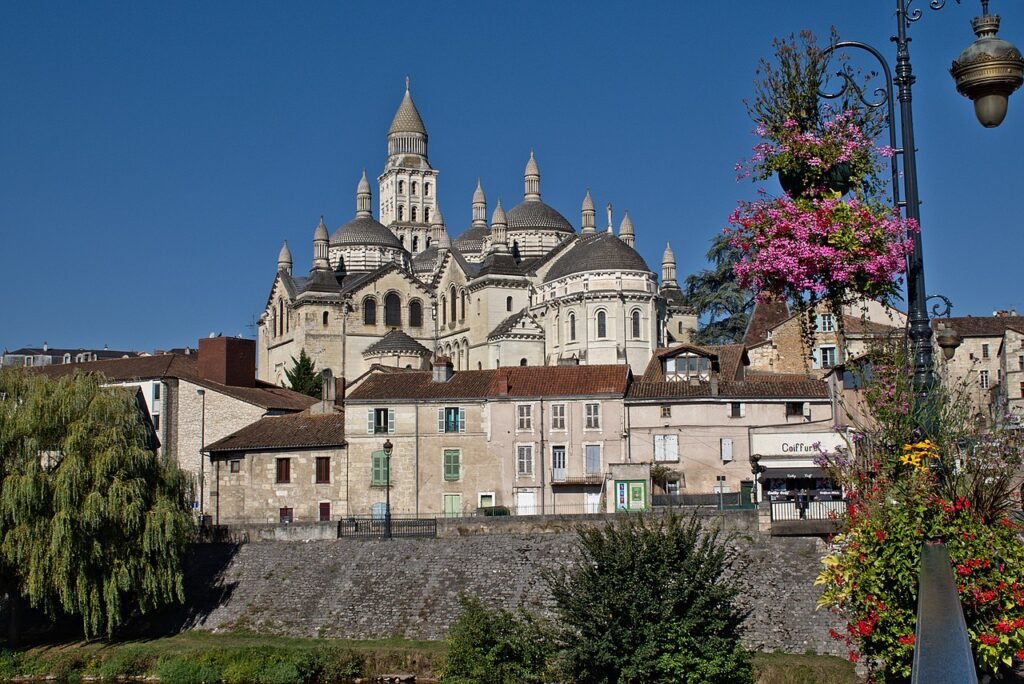
Cathédrale St-Front
This is the fourth church built here, on the summit of the puy over the Isle. A 6th-century AD chapel holding the relics of St Front was replaced in 1074 with a much larger church, to draw in pilgrims on the way to Compostela. In 1120, when this new church burned down, it was decided to build something extraordinary with five domes on a Greek cross, similar to St Mark’s in Venice. By the 19th century this marvel was a rickety disaster waiting to happen. After the Huguenots had damaged it in 1575 and destroyed the tomb of St Front, a streak of thoughtless restorations exacerbated the typical problems of old age.
From Place de la Clautre you can see what survives from the church of 1074: the austere façade fitted with the odd Roman fragment, lateral walls that now form an open courtyard, the bottom two-thirds of the squarish 57m bell tower, built in a style unique for the Middle Ages that may have inspired Abadie’s eccentricity. There are two confessions (tomb-shrines of saintly confessors) – one under the bell tower and the other under the west dome – and the little cloister with a ‘pine cone’ at its centre, a copy of a common Roman motif (the Vatican has a famous one in a courtyard), that originally topped the bell tower.
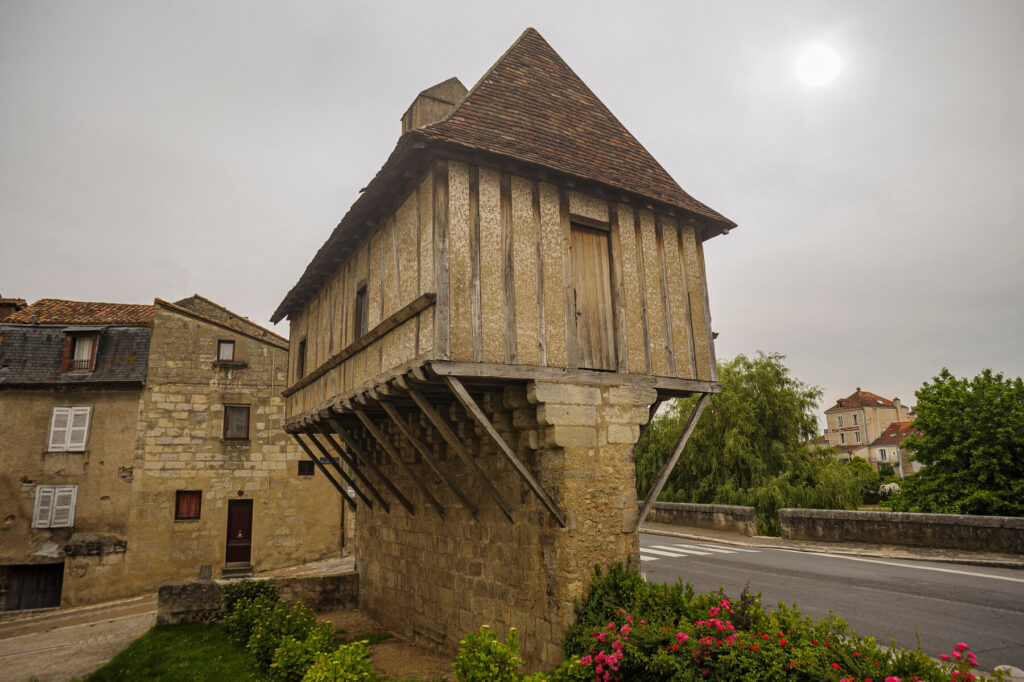
Medieval streets around St-Front
The north door of the cathedral opens on to Avenue Daumesnil, the centre of a fascinating web of 15th- and 16th-century pedestrian lanes. Much of the stone of their urbane houses was quarried from ancient Vesunna, and residents often leave their gates open to let passersby admire their curved inner stairs. The Vieux Moulin, perched on a river wall on Boulevard Georges Saumande, is a relic of the grain monopoly once held by the canons of St-Front. Just down the street, the 15th-century Maison des Consuls, the old seat of city government, reflects Périgueux’s late medieval-Renaissance heyday; there are beautiful views of the ensemble over the willowy banks of the Isle from the Pont des Barris.
Back up in Place Daumesnil, enter the picturesque Galeries Daumesnil by way of Rue de la Clarté: these are a set of old courtyards opened up to the public, and named after Pierre Daumesnil who was born at 7 Rue de la Clarté in 1776. Long narrow pedestrian Rue Limogeanne has been Périgueux’s busiest shopping street since the Middle Ages and is lined with Renaissance-era houses; no. 5, the Maison Estignard, is especially lovely with its dormers, mullioned windows and carvings of salamanders – a way of flattering François Ier, whose emblem they were.
In pretty Place St-Louis surrounded by restaurants and cafés, the Maison du Pâtissier (1518) has a sculpted porch and an inscription warning that anyone who speaks badly behind people’s backs is not welcome inside, for ‘The greatest glory is to displease the wicked.’
Musée d’Art et d’Archéologie du Périgord (MAAP)
This museum has something for every taste. The important prehistoric section has one of the oldest complete skeletons ever found, the 70,000 BC Neanderthal homme de Régourdou. There are Upper Palaeolithic carvings and engravings on bone and stone, among them the strange, disembodied Parade of Bison from Chancelade and a disc carved with does.
From later millennia there’s Gallo-Roman jewellery, domestic items and mosaics, an Alemanni sword, Visigothic and Frankish blades, a 6th-century Visigothic sarcophagus, a lacy fragment of a Carolingian chancel, and strange faces and slatternly mermaids that once adorned St-Front, a jewellery box that belonged to Fénelon’s family, and ceramics and enamels from Limoges.
The paintings aren’t overwhelming, but there is the Diptyque de Rabastens (1286), a rare work painted on leather from Toulouse, a Canaletto and Dutch works, and 20th-century works by Périgourdins, including sculptures by Jane Poupelet. Much of the ethnographic collection (from New Caledonia, the Cook Islands, Papua New Guinea and Africa) was brought back by Admiral Bougainville, who sailed around the world in 1768 for King Louis XV and introduced Europe to the flowers that bear his name, along with masks, idols and other art, including a 5m seashell necklace used as money.
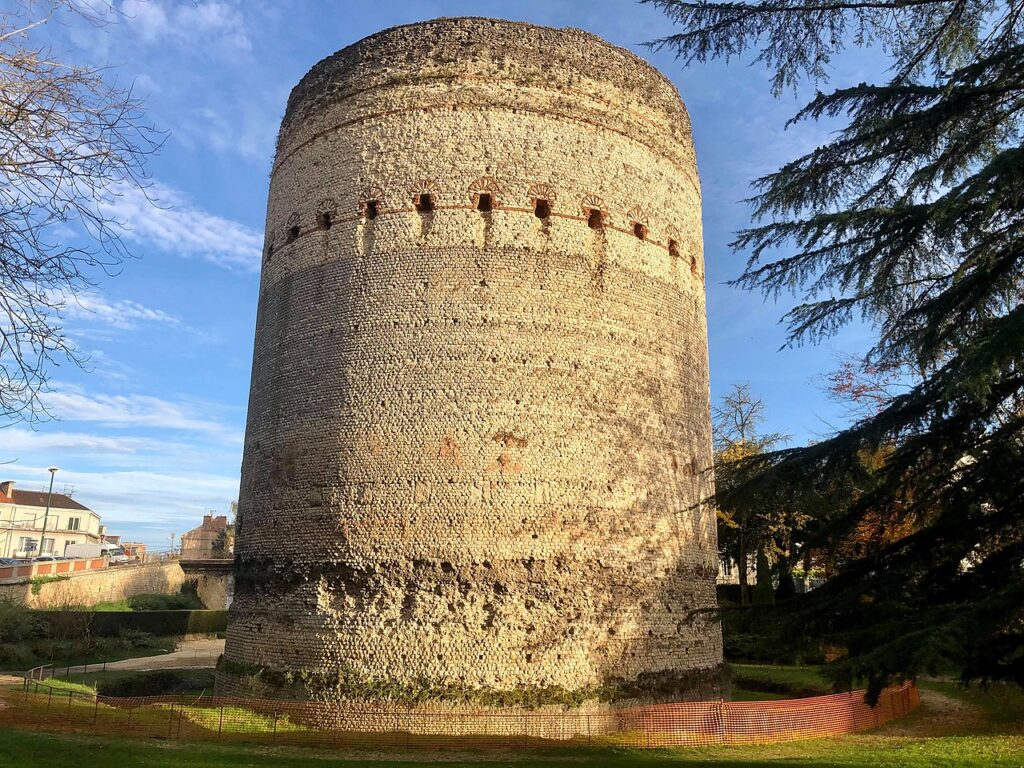
Tour de Vésone
According to ancient writers, this fantastical ruin once stood in the exact centre of Vesunna, in the middle of a peristyle square. It was the temple of the city’s tutelary deity, some murky Celtic goddess who didn’t like to be named. Today it stands alone in a park, an enigmatic stone and brick cylinder 20m high, with its breach attributed to St Front. Imagine this great cylinder as it must have appeared in the Middle Ages, still surrounded by some of its columns.
Note the row of sockets about 6m from the top; beams projected from here to hold up the cornice and roof, which would have been domed or conical – recalled in the unique, odd circular lantern on the top of St-Front’s bell tower. It’s the very image of the Tour de Vésone; this iconic, almost magical building must still have held Périgueux in its spell, and the Romanesque builders were able finally to capture it and Christianise it.
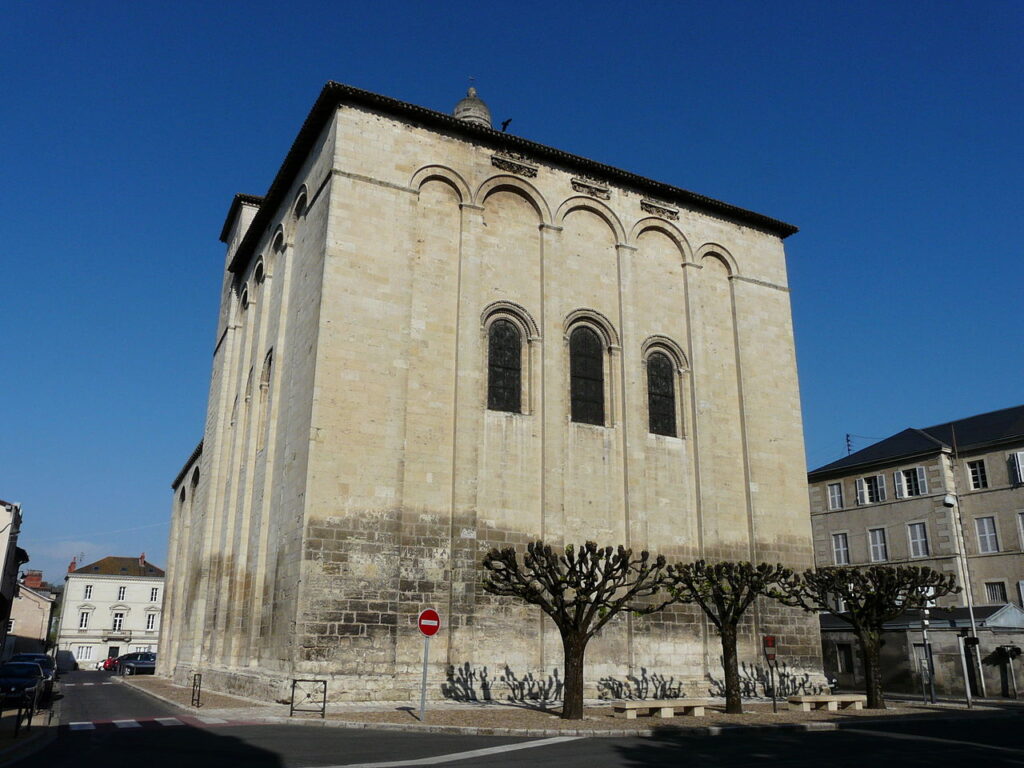
St-Étienne-de-la-Cité
The centre of the old Cité is marked by Périgueux’s oldest church, founded over a Temple of Mars in the 6th century. In the 12th century it was rebuilt in a style that became the prototype of the Périgourdin domed Romanesque church, with wide Byzantine cupolas not only over the crossing but cupping the length of the nave. Originally St-Étienne had four of these, culminating in a huge bell-tower porch; those busy Huguenots unkindly, and none too neatly, tore off the front half.
The two surviving bays are not only an important lesson in the origins of Périgourdin Romanesque, but are steeped in shadowy medieval solemnity, an atmosphere so lacking in St-Front. The first dome, from the early 1100s, is solid and primitive, lit only by tiny windows; the second, from around 1160, is elongated, lighter, and supported by twinned columns.
Inside, the arch from the tomb of Bishop Jean d’Asside (d1169) frames the Romanesque baptismal font, and there’s a medieval curiosity: a carved 12th-century Easter calendar. Back in the age of slow communications, each diocese had to puzzle out the right Sunday for Easter by observing the moon and calculating from a chart like this one.
Rocamadour
Rocamadour proudly bills itself as the ‘Second Site in France’, after Mont St-Michel. The two share extraordinary, fantastical settings, the very kind of naturally sacred places that attract legends like lightning rods. Rocamadour is the medieval French equivalent of a Pueblo village in North America, a vertical cliff-dwellers’ town, the beautiful golden stone houses and chapels piled up one on top of another over a deep ravine, while far, far below the little River Alzou continues its work of aeons, cutting even deeper into the gorge.
What to see and do in Rocamadour
Cité Médiévale
The pilgrims would enter Rocamadour through the 13th-century Porte du Figuier, one of four gates that defended the village’s one real street. Once in, past a gauntlet of souvenir shops, you’ll find a second gate, Porte Salmon (and the lift to the Holy City). Beyond this is the 15th-century Palais de la Couronnerie, now the Hôtel de Ville, where a beautiful tapestry of local flora and fauna by Jean Lurçat is on display. The street continues through another gate into the Quartier du Coustalou, the prettiest and least restored part of the village, with jumbly little houses and a fortified mill.
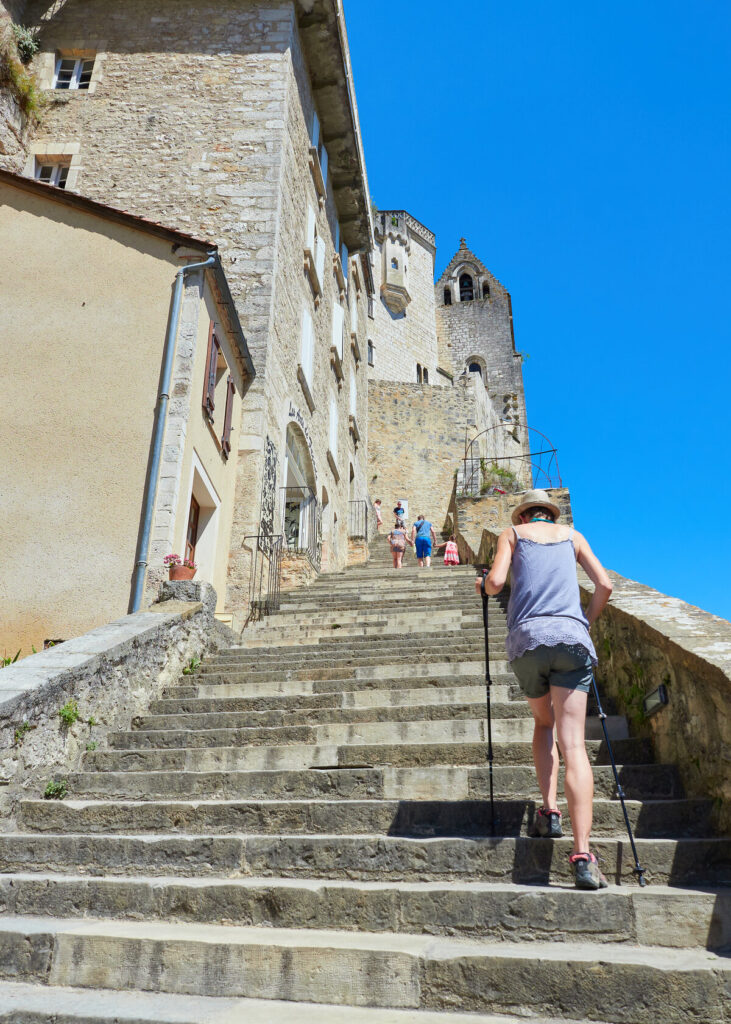
The Holy City
From Place de la Carretta the great stair, the 216-step Grand Escalier, leads up into the holy city; pilgrims still sometimes go up them on their knees. The first 144 steps lead to the Place des Senhals, where merchants sold holy medals (senhals in Occitan) made of lead and stamped with a picture of the Virgin.
Rocamadour’s oldest street, Rue de la Mercerie, extends from here, with the 14th-century Maison de la Pomette at its end. From here, continue up through the gate under the over-restored Fort, sometime residence of the bishops of Tulle.
Parvis de St-Amadour
At the top of the Grand Escalier, this small square is the centre of the holy city, where the pilgrims could visit seven churches, just as in Rome, but in a very abbreviated space. Today only Notre-Dame and St-Sauveur are open; for St-Michel, SS Anne and Blaise and L’Hospitalet and the Crypt of St-Amadour, you need to take the tourist office’s guided tour.
The 11th-century Basilique St-Sauveur makes good use of the cliff for a wall. Over the altar hangs a painted wooden 16th-century Christ crucified on a tree, his right side instead of the customary left pierced by the lance. Steps lead down into another of the seven churches, the simple 12th-century Crypt St-Amadour, where the relics of the saintly hermit were venerated. The Parvis also has the Musée Trésor d’Art Sacré (closed except for special occasions) dedicated to the composer Francis Poulenc, an atheist who converted to Catholicism after a vision here in 1936 and composed his Litanies à la Vierge Noire de Rocamadour. Inside are precious medieval reliquaries from Limoges, stained glass and 17th-century ex-votos.
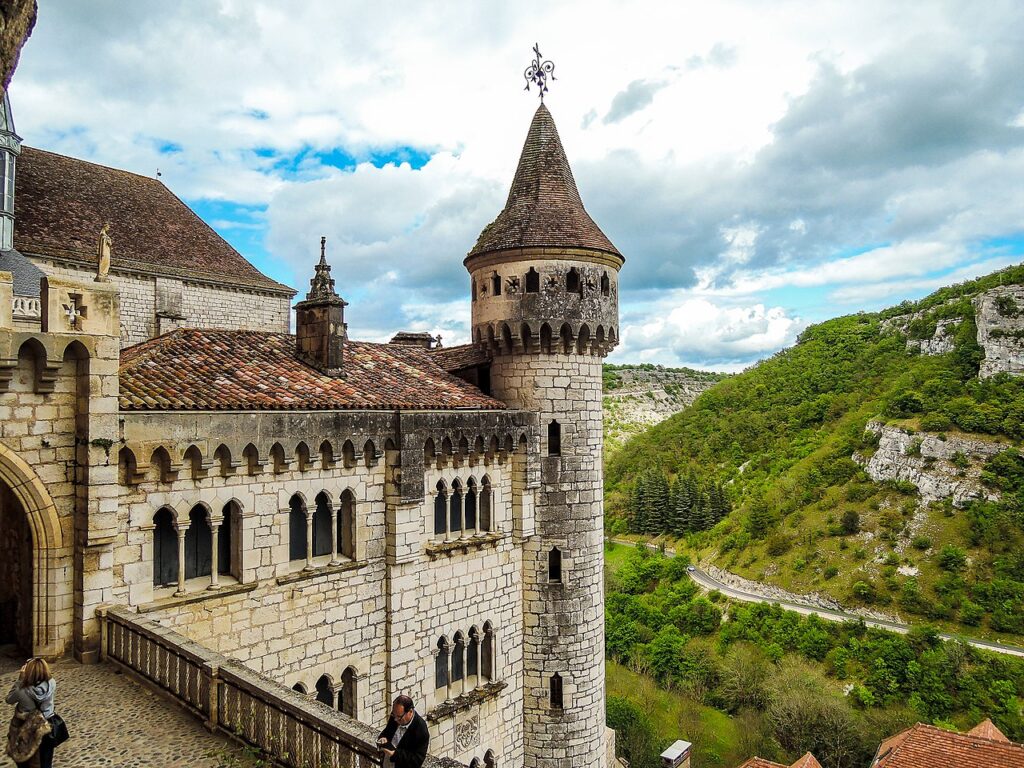
Parvis Notre-Dame
On the other side of St-Sauveur another 25 steps lead up to the church of Notre-Dame and the Flamboyant Gothic Chapelle Notre-Dame. This dates from 1479, after a rock crashed off the cliff through the original sanctuary. Inside, the miraculous Black Virgin holds court. Carved from walnut in the 11th century, she sits stiffly on her throne, almost a stick figure, the Christ Child balanced on her knee. Ex-votos testify to her heavenly influence: many are from Breton sailors saved from shipwreck after praying to the Virgin of the Rocamadour – including Jacques Cartier, who returned safely from his three voyages to Canada. Miracles were often foretold by the ringing of the 9th-century bell hanging from the roof. Chains from pilgrim petitioners still hang in the back of the chapel. Outside, high in the rock above the door, Durandal is still embedded in the stone, fastened by a chain to keep it from falling on someone’s head.
Sharing this upper square with Notre-Dame is the Chapelle St-Michel, with the overhanging cliff for a roof, decorated on the outside with colourful 12th- or 13th-century frescoes representing the Annunciation and Visitation. The patron of travellers, St Christopher, is painted below; to catch a glimpse of him was good luck, so he was always made extra big. Nearby, tucked in the rock is the newest chapel – to Notre-Dame de l’Ovalie (aka rugby!) Further up, a hairpinning path lined with the Stations of the Cross (or the much easier lift from the Parvis de St-Amadour) takes you up to the ramparts of the 14th-century château (€2 for the vertiginous view) and L’Hospitalet, the district named after a hostel-hospital founded in 1050 by Hélène de Castelnau for pilgrims en route to Compostela.
Le Rocher des Aigles
The eagle’s nest atop Rocamadour is a real one, thanks to the breeding programme for endangered birds of prey (including a condor) and parrots from Costa Rica. Watching them soar high over Rocamadour is pretty impressive, and you can visit them all before or after the show. Try to go to the last spectacle, when they bring out the owls.
Sarlat
Sarlat is one of the most beautiful and distinctive towns in France and the choicest stretch of the Dordogne as it flows out of Quercy past stunning villages such as Domme and La Roque-Gageac, and a mini-Rhineland with a castle around each bend.
‘Mon Dieu, there’s nothing here but foie gras!’ muttered an old farmer, brought by his relatives to Sarlat for a Sunday afternoon promenade. Of course he’s right: nearly every boutique glitters with stacks of shiny tins and jars. But such rich stuff fits Sarlat perfectly well, for, cocooned inside its clinking ring of sprawl, this golden Renaissance town is architecturally the foie gras of southwest France.
What to see and do in Sarlat
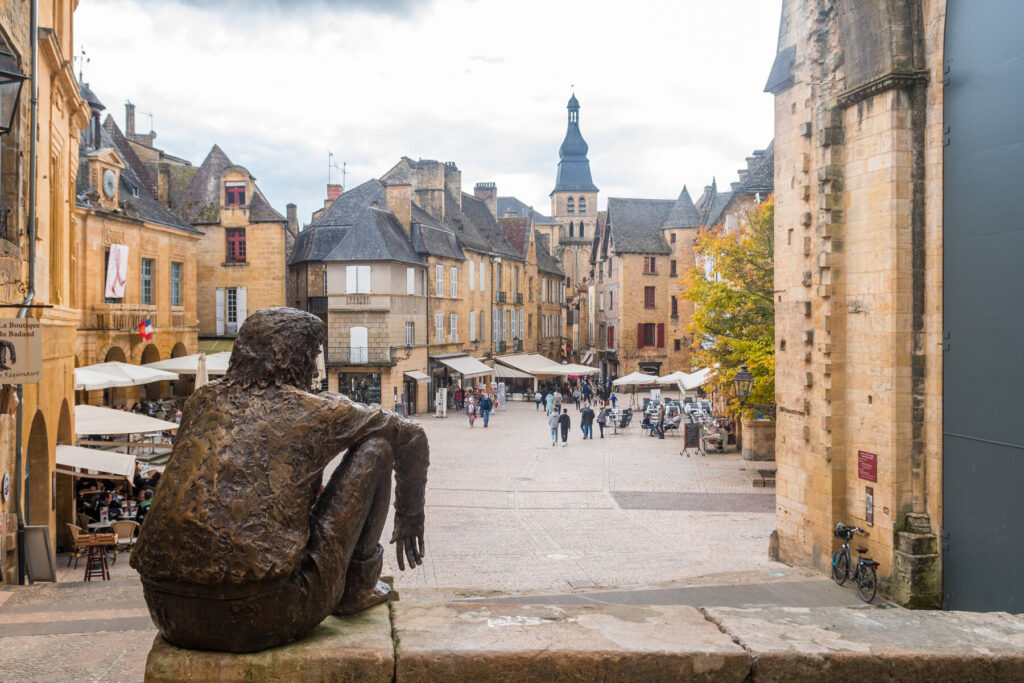
Place de la Liberté
All of the medieval lanes in Sarlat lead to this urbane, elongated vortex of a square. The 17th-century Hôtel de Ville is here, next to the Hôtel de Maleville, a 16th-century combination of three older houses, with two Renaissance façades – one French, one Italian. It belonged to Jean de Vienne, a local boy who owed his rise to high office to Henri IV (see the portrait medallions of the king and a woman – either Henri’s wife Marie de’ Medici, or his mistress Gabrielle d’Estrées). It was later owned by the family that produced Jacques de Maleville, a key author of Napoleon’s Code Civil.
The north end of the square is framed by the carcass of the church of Ste-Marie and a massive bell tower, completed in 1507. After being used to store saltpetre during the Revolution, it was sold for a pittance to a speculator, who lopped off its chancel and converted its chapels into shops; now it houses a covered market – with 15m-high doors designed by Jean Nouvel and a secret panoramic lift waiting to take you 45m up for views over Sarlat’s roofs.
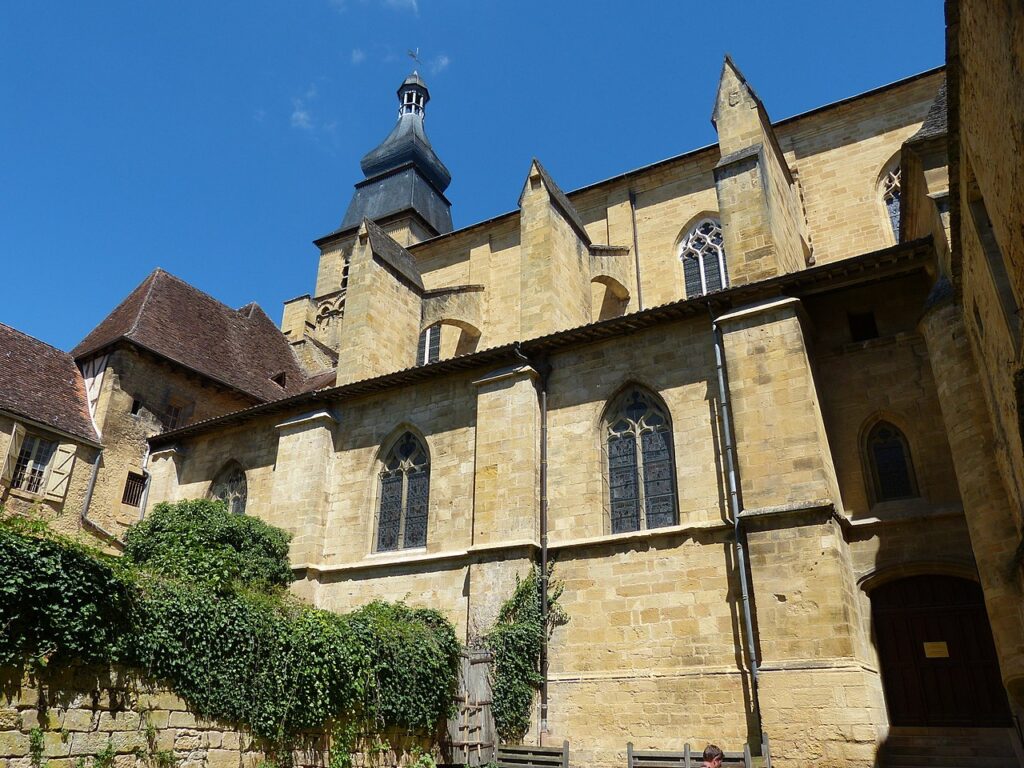
Cathédrale St-Sacerdos
This church with impressive flying buttresses and garlic bulb steeple replaces the old abbey church founded by Clovis – of which only the much-restored 12th-century Chapelle des Pénitents Bleus in Cour des Fontaines survives. The cathedral had to be reconsecrated in 1273, after a disgruntled monk with a crossbow shot the abbot while he was saying Mass. In 1504, Bishop Armand de Gontaut-Biron demolished this version (except for its Romanesque clocher-porche) in order to construct something grander. Unfortunately, it took until the dull 17th century to complete and holds nothing as fine as the bishop’s own tomb at Biron.
Adjacent to the cathedral, the former bishopric or Ancien Évêché (now the tourist office), has a handsome top-floor gallery in brick that looks as if it escaped from Italy – not surprising, as it was built by a cousin of Catherine de’ Medici, Cardinal Niccolò Gaddi, who added Bishop of Sarlat to his titles in 1533.
Hôtel de la Boétie
Opposite the cathedral in Place du Peyrou stands the most lavishly ornate town house in Sarlat (1525). The modern entrance is through the wide round arch of a former shop; richly ornamented mullioned windows dominate the upper three floors, squeezed between a vertiginously steep gable. The decoration reaches a curlicue frenzy in the dormer window, in frilly contrast with the sombre black lauzes of the roof.
The hôtel particulier was built by the father of the precocious humanist poet Étienne de la Boétie, who was born here in 1530. A student of the classics, Étienne was only 18 when he wrote his Discours de la servitude volontaire, asking why people willingly give up their liberty to support tyrants, when tyrants could never exist without people willing to give up their freedom, the most precious thing of all. Instead he suggested ‘voluntary servitude’ – obey the State or Church, pretend to believe what they say to believe from prudence (or, in those days, survival). Your mind, said La Boétie, belongs to you.
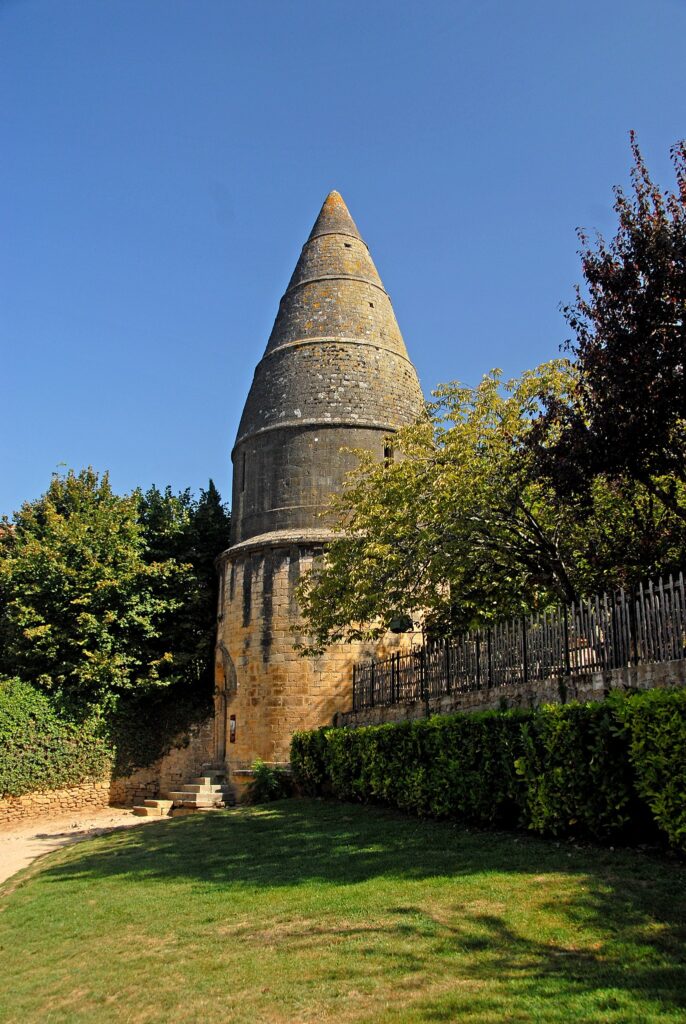
La Lanterne des Morts
Behind the cathedral, the Benedictine cemetery, the Jardin des Enfeus, consists of 12th–15th-century tombstones excavated and arranged on terraces. Above looms a giant stone bullet of a tower, the largest of several ‘Lanterns of the Dead’ in these parts – they can be found all over France, but most thickly in Aquitaine and all date from the 1100s.
A lanterne is round and sometimes square, with at least three small windows near the top. In the old days, it’s said a light would be hoisted up on a pulley to shine through the slits. Most, like this one, are found in cemeteries, although they are sometimes built into churches; the strange cupola on Périgueux’s St-Front may be one.
Beyond hints from folklore, we have no idea what purpose they served, but we can guess that it’s something genuinely old and strange, perhaps a survival of the old Celtic religion – the tower with small windows at the top is a form reminiscent of the cella in a Gallo-Roman temple. Were they lighthouses, guiding the souls of the dead? A fascinating thing about Sarlat’s Lanterne des Morts is its upper chamber. It’s sealed off, completely, mysteriously inaccessible, and no-one alive knows what’s inside.
St-Émilion
In 1999, UNESCO designated St-Émilion as a World Heritage Site for being ‘an outstanding example of a historic vineyard landscape that has survived intact and in activity to the present day’. Set in a natural amphitheatre, mellowed to the colour of old piano keys, this Dordogne town has been restored to its former beauty. But leave your high heels at home: lanes called tertres, unevenly paved with granite blocks from Cornwall (the ballast of England’s wine ships), are so steep that handrails have been installed down their centres.
For all that, St-Émilion keeps its greatest secrets underground – not only the ruby nectar in its cellars, beloved by medieval popes and English kings, but Europe’s largest subterranean church. Ideally arrive early to avoid the crowds of day trippers, or stay overnight.
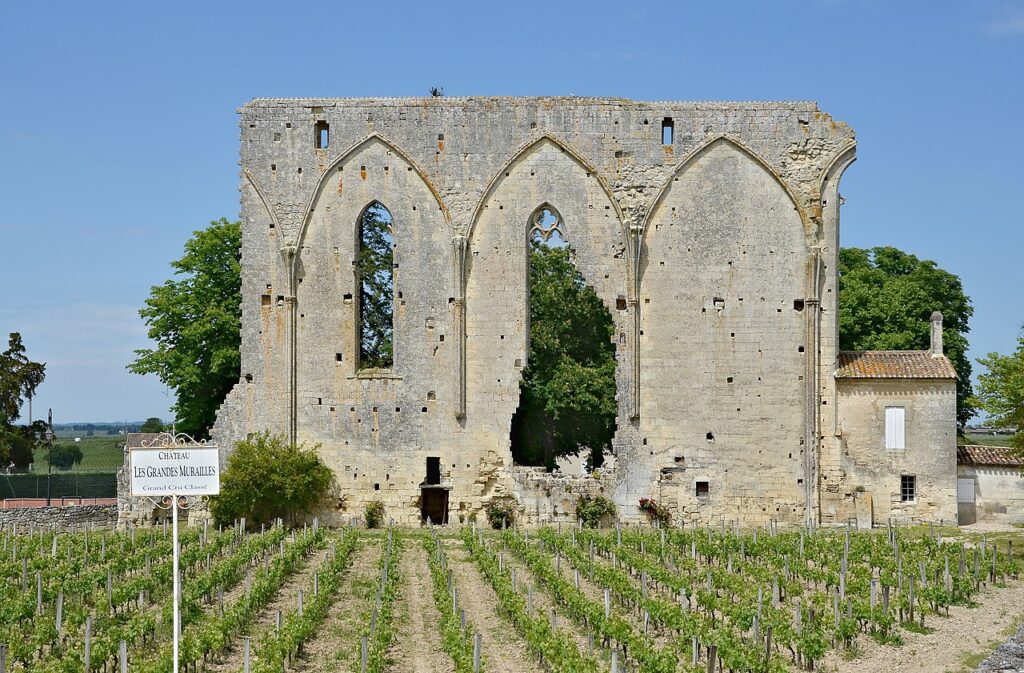
What to see and do in St-Émilion
Entering the town from the south on the D122, you’ll pass a public park built around the Maison Gaudet, home of the Girondin deputy Marguerite-Élie Guadet, who managed to flee Robespierre’s executions in Paris with seven other Girondins. They hid out for nine months in St-Émilion, but all but one were eventually captured by Robespierre’s henchmen and guillotined – ironically, only a few days before 9 Thermidor, when Robespierre himself got the chop. Across the road, rising abruptly out of a vineyard, the Grandes Murailles, a 20m wall with ogival arches, is all that remains of a Dominican monastery built in 1287; as it was outside the walls, it was easy prey for a marauding French army in 1337.
Just beyond is the main entrance to St-Émilion, the Place Leclerc. Take the first left to see the substantial remains of the once-sumptuous Palais Cardinal, built in 1316 by the Cardinal de Ste-Luce, nephew of Pope Clement V. Continue up Rue Gaudet, where just beyond Place du Chapitre the Dominicans rebuilt their Couvent des Jacobins, after a donation in 1378 by the English Lieutenant of Aquitaine, Jean de Neville. Until the Revolution, this church held the town’s main pilgrimage attraction: a statue of St Valéry, patron of St-Émilion’s vintners (now in the Collégiale). Brides would gently wipe the statue with their handkerchiefs while wishing to become pregnant; Valéry’s exact role in the matter was the cause of many pleasantries.
Further up, where the street forks, take Rue des Cordeliers for the Commanderie, an old Templar outpost (now a hotel) and the Cloître des Cordeliers, built in 1383. The pretty twin-columned 14th-century Franciscan cloister is a peaceful place – and this being St-Émilion, it’s now used as a wine bar, while the former church is a huge wine and gift shop. Some 20m below is an astonishing termitary of 3km of tunnels, where since 1892 they have aged bubbly and slightly sweet Crémant de Bordeaux, invented by a Monsieur Meynot, when there was a slump in wine sales. Book tours and tastings via the Les Cordeliers website, or take an electric tuk-tuk tour, which includes an above-ground tour of St-Émilion.
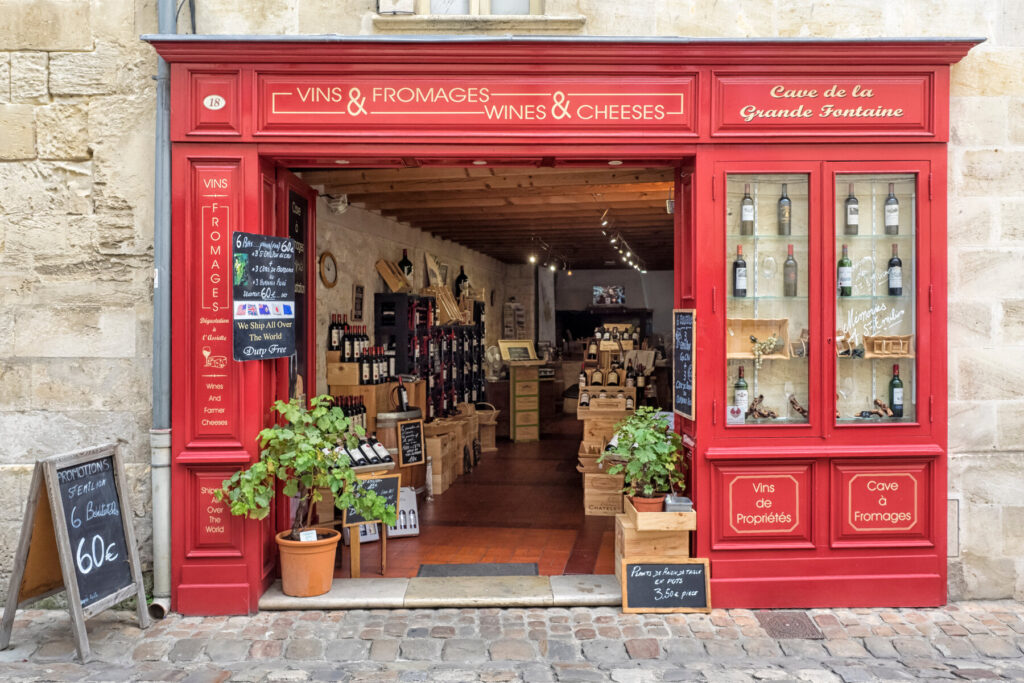
Backtrack to Rue Gaudet and Rue de la Cadène, which soon passes under the 16th-century arch of the Porte et la Maison de la Cadène, ‘of the chain’, by which a street could be quickly closed off in case of emergency. Note the half-timbered house on the left, decorated with a pair of grotesque heads and dolphins. Further up, Rue Gaudet runs into Place du Marché, a magnificent urbane stage set built over the town’s first cemetery, its cafés shaded by a Liberty Tree planted during the 1848 Revolution.
Toulouse
One thing that keeps this region from nodding off in its vats of duck fat and wine is this big pink dynamo on the Garonne. Toulouse, nicknamed La Ville Rose for its millions of pink bricks, has 1,360,000 and counting inhabitants, more than 110,000 university students, a well-preserved historic centre with the world’s biggest Romanesque church, and most of the EU’s aeronautics, space and related high-tech industries.
Instead of France’s fourth city, Toulouse should have been the capital of a twanging, Occitan-speaking nation called Languedoc, but it was knocked out of the big leagues in the 1220s by the popes and the kings of France and their henchman Simon de Montfort. Eight centuries later, Toulouse is rediscovering its mojo as the capital of Occitanie, a grand région stretching from the Dordogne to the Rhône, encompassing nearly all of the former territories of the once mighty Counts of Toulouse.
Spain extends her cape here, distilling enough passion to make Toulouse une ville d’émotion, emotion that spills over when its beloved rugby side, the Stade Toulousain, takes to the field. The city’s motto is Per Tolosa totjorn mai (‘For Toulouse, always more’). Always more sprawl and traffic jams, but also always more for visitors to see and do, showing off its air and space technology at the Cité d’Espace and Aeroscopia – along with the cunning steampunk marvels to ride in the Halle de la Machine.
What to see and do in Toulouse
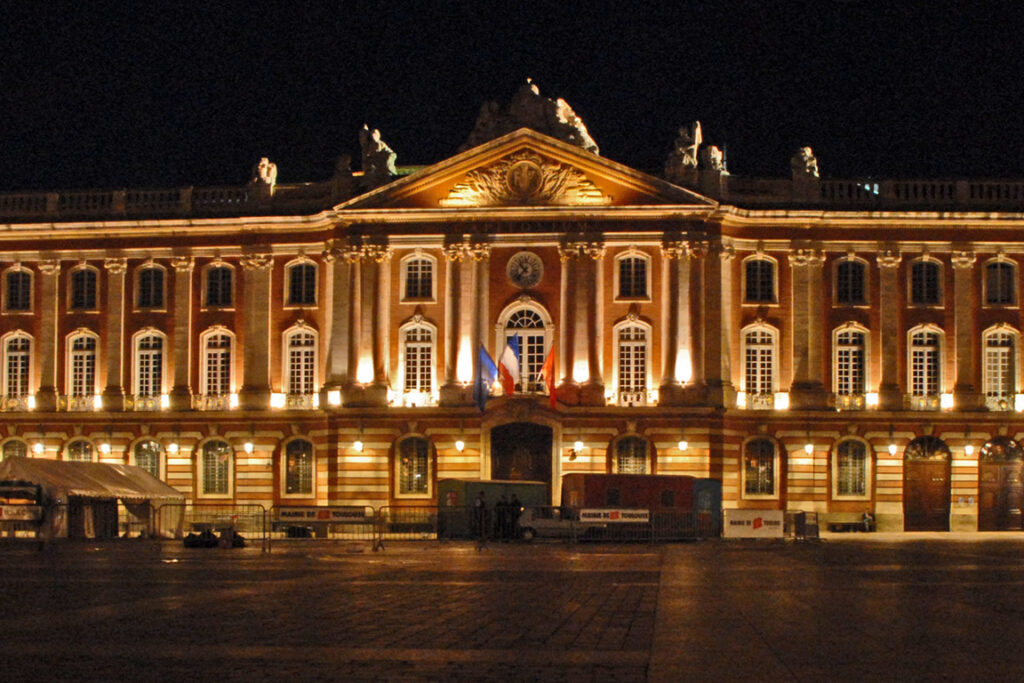
Place du Capitole
Toulouse’s front parlour dates from 1850, after a 200-year-long campaign to rid it of excess buildings. As a permanent memorial to the southern kingdom of nevermore, the centre of the pavement is marked by an enormous Cross of Languedoc, complete with symbols of the Zodiac added in 1993, by Raymond Moretti, who also decorated the ceilings of the square’s porticoes with scenes from the city’s history. This same golden cross on a red background hangs proudly from Toulouse’s city hall, the Capitole, or capitolium as it reads on the façade, bowing to a 16th-century story claiming that ancient Rome got its Capitol idea from Toulouse’s temple of Capitoline Jupiter.
The portal on the right belongs to the Théâtre du Capitole, while over the central door eight pink marble columns represent the eight Capitouls. Pedestrians can cut through the magnificent gateway into the inner Cour Henri IV, with a statue of said king, who in 1602 gave his permission for the construction of the courtyard. Henri would have said non! had he known what was going to happen on this spot 30 years later, thanks to the jealous rivalries and schemes of his two neurotic sons, Louis XIII and Gaston d’Orléans (‘Monsieur’ for short), and the prime minister and arch-puppeteer Cardinal Richelieu.
The grand stair leads to the delightful public rooms, decorated between the mid 19th century and into the 1920s with monumental picture book illustrations of the history of Toulouse. The vast Salle des Illustres is lined with paintings of Toulouse’s moments of glory, including the stupendous Pope Urban II Entering Toulouse in 1095 to Summon Raymond IV to the First Crusade by Benjamin Constant and the Victory over Simon de Montfort by Laurens, complete with the Apotheosis of the Woman Who Killed Simon de Montfort on the ceiling, honouring the city’s anonymous heroine.
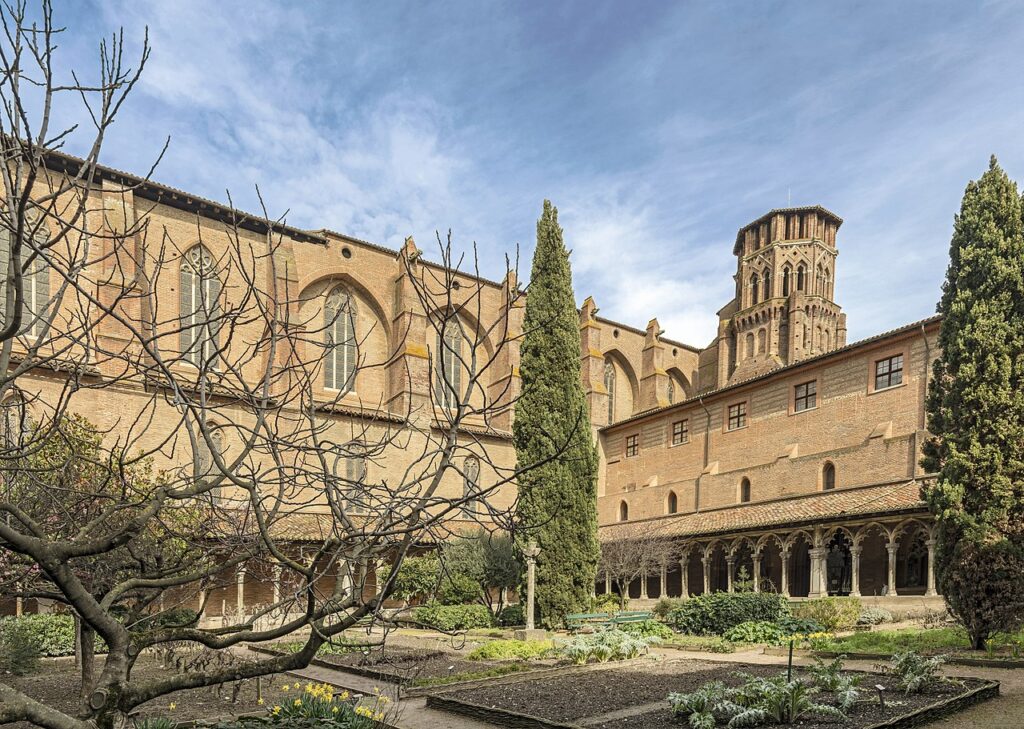
Musée des Augustins
Housed in a 14th-century Augustinian convent, this treasure chest of art owes its founding to Alexandre Dumège, the self-taught medieval-art-loving son of a Dutch actor. During the Revolution, as the Ville Rose went about gaily smashing up its fabulous architectural heritage as ordered in 1790 by the Convention, ‘to leave standing no monument that hinted of slavery’, Dumège defiantly and singlehandedly rescued most of the contents of this museum, then opened its doors in 1794.
The Romanesque and Gothic sculptures, especially the capitals from long-gone cloisters, steal the show. The most beautiful come from St-Étienne – a delicate, almost fluid scene of the dance of Salome and the beheading of John the Baptist. There are scenes from a 14th-century retable, the Group of Three Persons, One of Whom is Strangled by a Monster, and a crooning choir of gargoyles; there’s a sarcophagus with a web-footed bird carved in the side, believed to belong to the Visigoth Queen Ranachilde – la reine Pédauque, the goose-foot, who was said to paddle around Toulouse in aqueducts. There are reliefs by Nicolas Bachelier, and portraits of Capitouls; one of their oldest prerogatives was the droit d’image – the right to have their portraits painted, a rare honour in the 13th and 14th centuries. There’s an extremely unpleasant Apollo Flaying Marsyas by Guido Reni, and paintings are by Van Dyck, Rubens, Murillo, Rigaud, Simon Vouet, Delacroix, Ingres, Manet, Morisot, Vuillard, Maurice Denis and Toulouse-Lautrec.
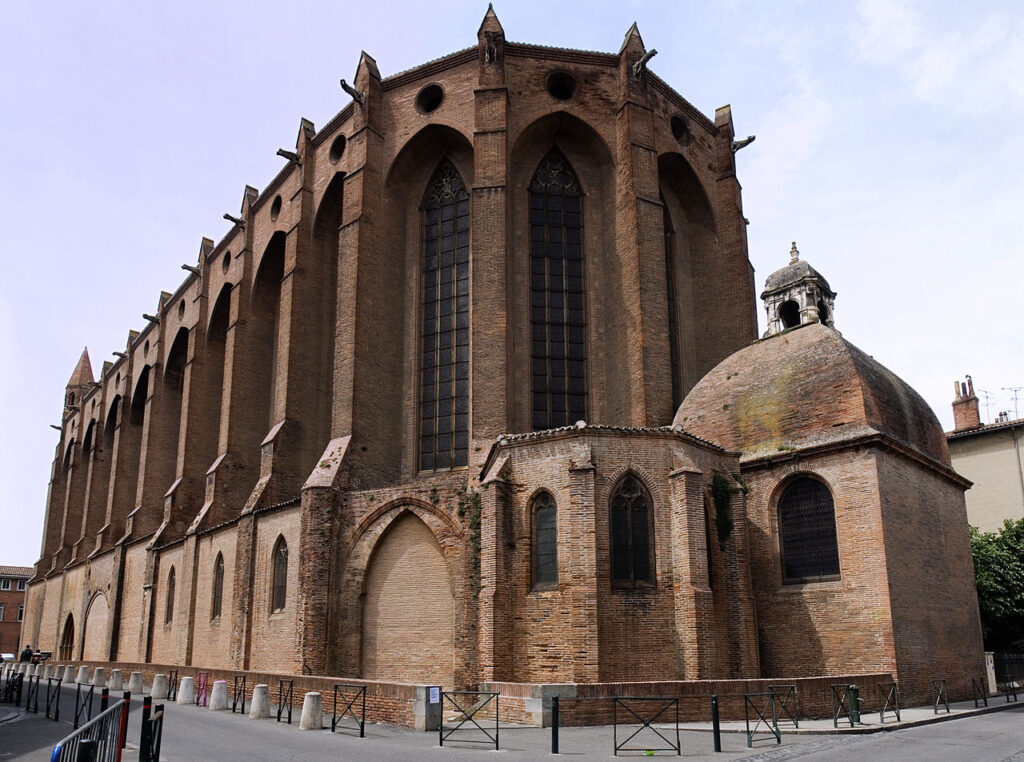
Les Jacobins
Just west of Place du Capitole stands the great Dominican mother church, Les Jacobins, one of the masterpieces of southern French Gothic. The Spanish priest Domingo de Guzmán or Dominic had tried to convert the Cathars before the Albigensian Crusade, although the persuasive powers of one man, even a saint, proved negligible in the face of an intellectual revolt against the openly corrupt clergy. By 1206 Domingo had converted enough women to found a convent, which became the germ of his Order of Preaching Friars, established in Toulouse in 1215. Confirmed by the pope in 1216, the new Dominican order quickly found adherents across Europe.
The church is the perfect expression of the 13th-century reaction to Rome’s love of luxury. Gargoyles are the only exterior sculpture in this immense but harmonious brick pile of buttresses, alternating with Flamboyant windows; its octagonal bell tower of brick and stone crowned with baby towers is a landmark of the Toulouse skyline. The interior is breathtakingly light and spacious, consisting of twin naves divided by seven huge columns, at 28m the tallest in any Gothic church, anywhere, criss-crossed by a fantastic interweaving of ribs in the vault, reaching an epiphany in the massive Flamboyant palmier in the apse. The painted decoration dates from the 13th to the 16th century, but only the glass of the rose windows on the west side is original. The 19th-century gilded reliquary shrine of St Thomas Aquinas was returned to the high altar in 1974.
Hôtel de Bernuy
This was one of the city’s most splendid residences, built in 1504 by a pastel merchant from Burgos, Don Juan de Bernuy, a Spanish Jew who became a citizen – and Capitoul – of Toulouse. Although Gothic on the outside, architect Loys Privat designed an eclectic courtyard, a mix of Gothic, Plateresque and Loire château, topped by a lofty tower rivalling those of all the other pastel nabobs. De Bernuy had a chance to repay France for the fortune he made when François Ier was captured at the battle of Pavia by Charles V and imprisoned in Madrid; the king fell gravely ill, but no-one could afford the ransom of 1,200,000 gold écus demanded by the emperor – until de Bernuy bailed him out.
In his distress the king had promised an ex-voto to St Sernin if he survived, and in the ambulatory there you can see the black marble statue he donated when he came in 1533 to thank the saint and de Bernuy. Not long after de Bernuy’s time, the Jesuits took over his mansion and made it into a college, now the prestigious Lycée Pierre de Fermat, named after its star pupil.
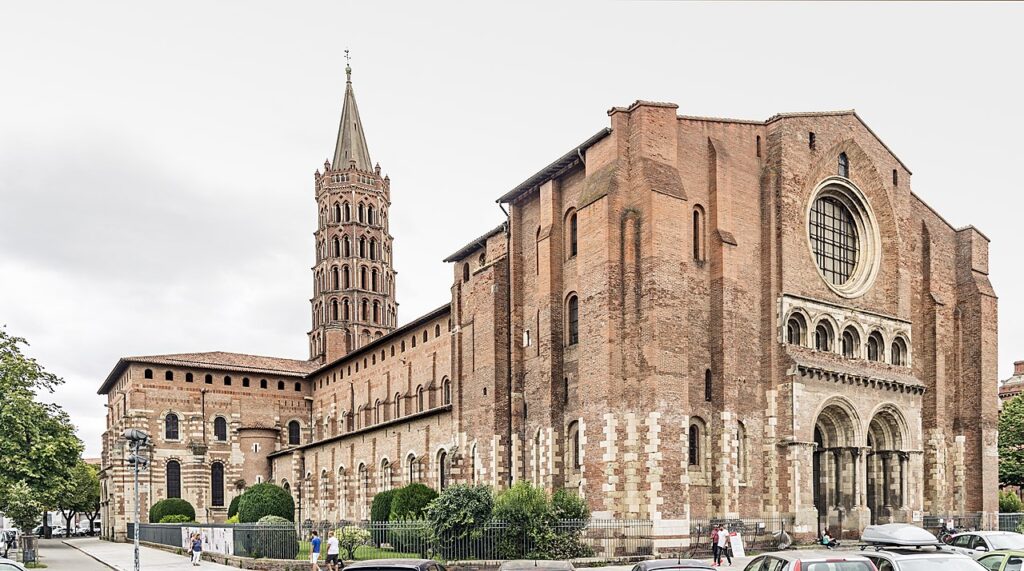
Basilique de St-Sernin
Sernin’s tomb at Notre-Dame-du-Taur attracted so many pilgrims and Christians who desired to be buried near him that in 403 AD a martyrium was built 300m to the north. The saint’s remains were relocated here; Charlemagne, who always seemed to travel with a trunk of sacred bones, donated a pile, and it wasn’t long before tombs lined the length of Rue du Taur. In 1075, just as the Compostela pilgrimage was picking up steam, it was decided by the canons of St Sernin that they needed something far grander to deal with the pious throngs. The construction of a new basilica was of such import that in 1096 Pope Urban II consecrated its marble altar while recruiting Count Raymond IV as the leader of the First Crusade.
In 1220, St-Sernin was finished. At 115m long, with a 46m transept, it’s the largest surviving Romanesque church in the world (only Cluny, destroyed in the Revolution, was bigger). It was begun at the same time, and has the same plan as the basilica of St James at Compostela, designed to accommodate crowds of pilgrims: a cross, ending in a majestic semi-circular apse with five radiating chapels. In the 19th century the abbey and cloister were demolished, and in 1860 Viollet-le-Duc was summoned to restore the basilica. He spent 20 years on the project – and botched the roof so badly that a century later it was in danger of collapse, hence a pricey ‘de-restoration’ project to undo Viollet-le-Duc’s mischief. Today it’s a UNESCO World Heritage Site as part of the Camino de Santiago de Compostela.
Related books
For more information, see our guide to Dordogne & Lot:
Related articles
You’ll be spoilt for choice.
